The Lone Gunmen / Harsh Realm – music by Mark Snow
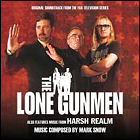 Look up “SF television scoring of the past 20 years” and you might as well look up Mark Snow, who first brought himself to genre audiences’ attention as the sole musical maestro of every episode of The X-Files. What’s more, during much of the ’90s, he was concurrently working on several other Fox genre shows, also created by The X-Files’ Chris Carter, and more often than not those shows were X-Files spin-offs. This doesn’t even count other genre fare (i.e. UPN’s Nowhere Man). These days, Snow is ensconsed in his own musical fortress of solitude, scoring teen-Superman kinda-sorta-prequel Smallville, but he’s also handed the keys to that fortress to La-La Land Records, who has a number of Snow titles available now or coming soon.
Look up “SF television scoring of the past 20 years” and you might as well look up Mark Snow, who first brought himself to genre audiences’ attention as the sole musical maestro of every episode of The X-Files. What’s more, during much of the ’90s, he was concurrently working on several other Fox genre shows, also created by The X-Files’ Chris Carter, and more often than not those shows were X-Files spin-offs. This doesn’t even count other genre fare (i.e. UPN’s Nowhere Man). These days, Snow is ensconsed in his own musical fortress of solitude, scoring teen-Superman kinda-sorta-prequel Smallville, but he’s also handed the keys to that fortress to La-La Land Records, who has a number of Snow titles available now or coming soon.
The label has already issued a 2-CD set of Snow’s music from the first X-Files spinoff, the moderately-successful mid-’90s show Millennium, but this CD focuses on the less prominent X-Files offspring, the short-live Lone Gunmen, and another brief Chris Carter creation, the stylized “dystopian future” of Harsh Realm (which wasn’t connected to the X-Files). As different as these two shows sounded, they’re a good fit for sharing a soundtrack CD, as both are fairly atypical of Snow’s usual pad-heavy, atmospheric sound from The X-Files.
The music from The Lone Gunmen takes its cues from its characters, the less-than-deadly-serious trio of conspiracy theorists who aided and abetted FBI Agent Fox Mulder in several X-Files episodes. Now on their own, the Lone Gunmen tried to peel back the layers of other conspiracies with their unique talents, while having to deal with the fact that while they’re perfectly competent “back room guys,” they’re ill-equipped to be action heroes on their own. The show’s theme spoofs the echoing bass guitar of the James Bond franchise after kicking off with a tribute to Hendrix’ electric guitar rendition of “The Star-Spangled Banner”, while the score cues themselves rely heavily on pizzicato string samples, further use of the bass guitar, and piano.
Harsh Realm veers closer to X-Files territory with its more introspective piano/synth material, but it doesn’t exactly lull anyone to sleep. One track in particular, “The Challenge”, is a marvel of pounding industrial percussion samples that could’ve been recorded yesterday.
 Standouts from the album include the Lone Gunmen cuts “G.I. Jimmy,” “Elmers” (almost Carl Stalling-esque in places) and “Tailing” (with its surprising minor-key reprise of “The Star-Spangled Banner”), while the Harsh Realm highlights include the unease-inducing “Jump Back”, and “The Challenge”, which almost sounds like a ’90s prototype for the Torchwood theme.
Standouts from the album include the Lone Gunmen cuts “G.I. Jimmy,” “Elmers” (almost Carl Stalling-esque in places) and “Tailing” (with its surprising minor-key reprise of “The Star-Spangled Banner”), while the Harsh Realm highlights include the unease-inducing “Jump Back”, and “The Challenge”, which almost sounds like a ’90s prototype for the Torchwood theme.
The Lone Gunmen
- The Lone Gunmen Main Title (0:45)
- Empty (0:23)
- Motiv-8 (1:37)
- Just What We Needed (2:42)
- Lost Causes (1:05)
- Rectal Palpation (1:44)
- G.I
- Jimmy (2:14)
- The Vaults (2:30)
- Lost Puppy / Confession (3:30)
- Elmer’s (2:28)
- Sawsall (5:13)
- El Palacio (1:56)
- El Lobo (1:37)
- Sling Blade (2:23)
- Wool / Poly Blend (1:40)
- Tailing (3:44)
- Memories Of Youth (1:12)
- The Lone Gunmen Theme – Alternate (0:49)
Harsh Realm
- Harsh Realm Main Title (0:46)
- Overlooking Tradition (1:28)
- The Wound (2:35)
- Love Letter (2:26)
- Virtual Vista (1:00)
- Chain Gang (1:45)
- Jump Back (5:33)
- Harsh Realm Main Title – Long (3:22)
- The Challenge (1:57)
- Thirsty (2:40)
- Trickster (3:47)
- Two On A Switch (2:33)
- Roadblock (3:50)
- The Conspirators (1:22)
- Harsh Realm Main Title – Full (3:45)
Released by: La-La Land Records
Release date: 2010
Total running time: 77:27
Inception – music by Hans Zimmer
 Accompanying one of 2010’s biggest mess-with-your-mind movies, Hans Zimmer’s darkly atmospheric soundtrack is enjoyable on its own too. Zimmer makes excellent use of his trademark rapid-fire cello section (see also: Batman Begins, The Dark Knight, or almost any other action blockbuster Zimmer has scored in the past ten years) as well as some inspired guitar work by Johnny Marr, but for some of the movie’s dreamier sequences (and it really is all about dreaming), he also introduces an unsettlingly unresolved four-chord sequence, providing a thoughtful interlude for the movie’s more thoughtful moments.
Accompanying one of 2010’s biggest mess-with-your-mind movies, Hans Zimmer’s darkly atmospheric soundtrack is enjoyable on its own too. Zimmer makes excellent use of his trademark rapid-fire cello section (see also: Batman Begins, The Dark Knight, or almost any other action blockbuster Zimmer has scored in the past ten years) as well as some inspired guitar work by Johnny Marr, but for some of the movie’s dreamier sequences (and it really is all about dreaming), he also introduces an unsettlingly unresolved four-chord sequence, providing a thoughtful interlude for the movie’s more thoughtful moments.
That sequence, the backbone of the whole score, either gently hints that something is amiss with what some of the characters (and the audience) perceives as reality, or telegraphs its with gigantic, ominous, end-of-the-world blasts of low brass. On CD, the theme is soft-pedaled a bit until it blows you out of your seat in “The Dream Is Collapsing”.
Other thematic material gradually appears, from the boisterous five-minute balls-to-the-wall action cue “Mombasa” to more strangely unsettling melodies in “One Simple Idea” and “Dream Within A Dream” – again, using chord sequences that seem circular because there’s not an obvious beginning or end. “Radical Notion” slowly brings in a pulsating low string ostinato that grows until it washes everything else out pretty spectacularly. Even when a more positive variation on one of these primary themes appears late in the score (and the movie), it has a bittersweet sound – and it still doesn’t quite come to a definitive resolution.
In some ways, Zimmer’s music for Inception summons up memories of the late, great John Barry’s score for The Black Hole – musically, it’s beautiful, but much of the score inspires a growing sense of pure dread. Considering how highly regarded Barry’s soundtrack has been, this is nothing but a compliment. (Given Zimmer’s trademark sound of  repeating low string ostinatos, the Inception soundtrack should also be on the list of anyone who spent all of 2010 eagerly waiting for the Tron Legacy soundtrack.)
repeating low string ostinatos, the Inception soundtrack should also be on the list of anyone who spent all of 2010 eagerly waiting for the Tron Legacy soundtrack.)
There’s a reason the music from Inception has earned Hans Zimmer an Oscar nomination (one of several for Inception overall, I might add). Even when I’ve liked Zimmer’s work in the past, it hasn’t had quite the depth and epic scale that Inception has. Like the storyline it accompanies, it sticks in your head.
- Half-Remembered Dream (1:13)
- We Built Our Own World (1:55)
- Dream Is Collapsing (2:24)
- Radical Notion (3:43)
- Old Souls (7:44)
- 528491 (2:23)
- Mombasa (4:52)
- One Simple Idea (2:28)
- Dream Within A Dream (5:04)
- Waiting For A Train (9:28)
- Paradox (3:22)
- Time (4:35)
Released by: Reprise
Release date: 2010
Total running time: 49:11
Ben Folds / Nick Hornby: Lonely Avenue
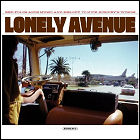 Ever since this album was first announced as a project where Folds would be putting Hornby’s words to music, one question kept running through my head: since when does Ben Folds need help coming up with lyrics for story songs? I mean, the man has practically assumed the story-song-writer throne abdicated by Billy Joel, and almost all of his output is a story song of one kind or another. I mean, if you’re going to have help, you might as well have help from an award-winning novelist, but… Ben Folds needs an assist writing story songs? Really?
Ever since this album was first announced as a project where Folds would be putting Hornby’s words to music, one question kept running through my head: since when does Ben Folds need help coming up with lyrics for story songs? I mean, the man has practically assumed the story-song-writer throne abdicated by Billy Joel, and almost all of his output is a story song of one kind or another. I mean, if you’re going to have help, you might as well have help from an award-winning novelist, but… Ben Folds needs an assist writing story songs? Really?
As it so happens, it’s not such a bad deal. Folds and Hornby have a mutual admiration society going on, so they’re on each other’s wavelength. And there are some great results from that collaboration, even though at its heart, Lonely Avenue lives up to its name – it’s a bit of a bummer of an album. At the very least, a lot of the songs deal with relationships fraught with mistakes; zoom in a little bit further, and quite a few of them concern themselves with infidelity of one kind or another. Lonely Avenue isn’t the sunniest album to arrive in the past year.
Not that this means there isn’t some great music on there. The highlight of the album is “Password”, which starts out painting its protagonist in a slightly creepy, stalker-ish light as he guesses his way through his significant other’s passwords. His confidence that he knows everything about her vanishes as soon as he gets far enough to figure out that – surprise, surprise – there’s another man. The dramatic payoff is nicely handled musically, and the rest of it is just a gorgeous song with some of the best vocal harmonies anyone recorded in 2010.
A close runner-up for the great harmonizing award goes to “Claire’s Ninth”, which deals with a child of divorced parents wishing she could have “two birthdays” like all of her friends, as opposed to the awkward event that she’s putting up with where various family members are barely maintaining civility.
Somewhat more raucous are songs like “Your Dogs” (a litany of complaints sung to a white-trash neighbor) and the other highlight of the album, “Levi Johnston’s Blues”, chronicling what was likely going through the mind of Bristol Palin’s boyfriend at about the time her mother was announced as a vice-presidential candidate. Its hilarious, not-safe-for-work lyrics are surprisingly apolitical – by the end of the song, no one mentioned in the lyrics really comes across as an angel, not even Johnston himself. And in places, despite the hard-driving chorus, the song is surprisingly pretty.
 Overall, the music is great, and the lyrics are unusually dark – and yes, I do know that I’m talking about someone who once spun a radio hit out of a story about taking his then-girlfriend to get an abortion. Folds has never shied away from heavier lyrical material (and I love him for it), but Hornby’s words seem to lack the deft wit that Folds has used in crafting lyrics before – ironic, since the author of books such as “High Fidelity” isn’t without a sense of humor himself. Lonely Avenue is a lovely ride into some not-so-uplifting territory – music to go along with a rainy day.
Overall, the music is great, and the lyrics are unusually dark – and yes, I do know that I’m talking about someone who once spun a radio hit out of a story about taking his then-girlfriend to get an abortion. Folds has never shied away from heavier lyrical material (and I love him for it), but Hornby’s words seem to lack the deft wit that Folds has used in crafting lyrics before – ironic, since the author of books such as “High Fidelity” isn’t without a sense of humor himself. Lonely Avenue is a lovely ride into some not-so-uplifting territory – music to go along with a rainy day.
- A Working Day (1:50)
- Picture Window (3:42)
- Levi Johnston’s Blues (5:15)
- Doc Pomus (4:13)
- Your Dogs (3:23)
- Practical Amanda (3:52)
- Claire’s Ninth (3:49)
- Password (5:21)
- From Above (4:04)
- Saskia Hamilton (3:09)
- Belinda (6:13)
Released by: Nonesuch
Release date: 2010
Total running time: 44:51
Malibu – Robo Sapiens
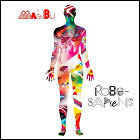 Ever since I heard the TV Eyes album a few years ago, I’ve been pining for more from that particular side project. Given that it’s a side project for Jellyfish alumni Roger Joseph Manning Jr. and Jason Falkner, and Manning’s occasional collaborator Brian Reitzell, it’s a given that it might be a while before we hear these busy musicians reform TV Eyes. Little did I know that Manning and his cohorts basically followed up on that album under a different name, only a year later!
Ever since I heard the TV Eyes album a few years ago, I’ve been pining for more from that particular side project. Given that it’s a side project for Jellyfish alumni Roger Joseph Manning Jr. and Jason Falkner, and Manning’s occasional collaborator Brian Reitzell, it’s a given that it might be a while before we hear these busy musicians reform TV Eyes. Little did I know that Manning and his cohorts basically followed up on that album under a different name, only a year later!
Malibu is a pseudonym for Manning, and Robo Sapiens is Malibu’s debut album of heavily-’80s-influenced dance pop. This isn’t normally a genre I’d spend too much time with, but as with TV Eyes, Manning’s own leanings make sure that the ’80s influence is worn on Malibu’s sleeve for all to see. The opening track, “Yesteryear”, kicks in with arpeggiating keyboards and echoplexed guitar licks courtesy of Jason Falkner, and the retro synths are the real deal, restored for these sessions. It sounds like it should be the background music for a kick-ass TV sports montage.
Other highlights include “Rubber Tubes”, “German Oil” and “Parisian Nights”, latter of which takes a very circa-1980 sound and then flirts with chiptunes in the same track; there are quite a few songs with lyrics here, but almost all of the lyrics are processed through a vocoder or some other means of creating a robotic sound. The best example of this is “Please Don’t Go”, though there are plenty of others. For those looking for a solid TV Eyes connection, there’s an extended version of “She Gets Around” here, which fits in perfectly with the sound of the rest of the album.
 Now that we know that these boys aren’t averse to revisiting the ’80s just for the pure musical fun of it, I all but demand a repeat engagement – whether as TV Eyes or as Malibu. Manning and friends have managed to distill all that was cool about ’80s music into two very cool projects. Let’s go for the trifecta.
Now that we know that these boys aren’t averse to revisiting the ’80s just for the pure musical fun of it, I all but demand a repeat engagement – whether as TV Eyes or as Malibu. Manning and friends have managed to distill all that was cool about ’80s music into two very cool projects. Let’s go for the trifecta.
- Yesterday (5:34)
- The Bounce (6:19)
- German Oil (6:18)
- Sidekicks (7:12)
- She Gets Around (6:21)
- Rubber Tubes (5:33)
- Parisian Nights (5:09)
- Animal Lovin’ Ken (6:11)
- Time To Time (5:05)
- D.I.E.T. (6:31)
- Please Don’t Go (4:20)
Released by: Expansion Team
Release date: 2007
Total running time: 64:33
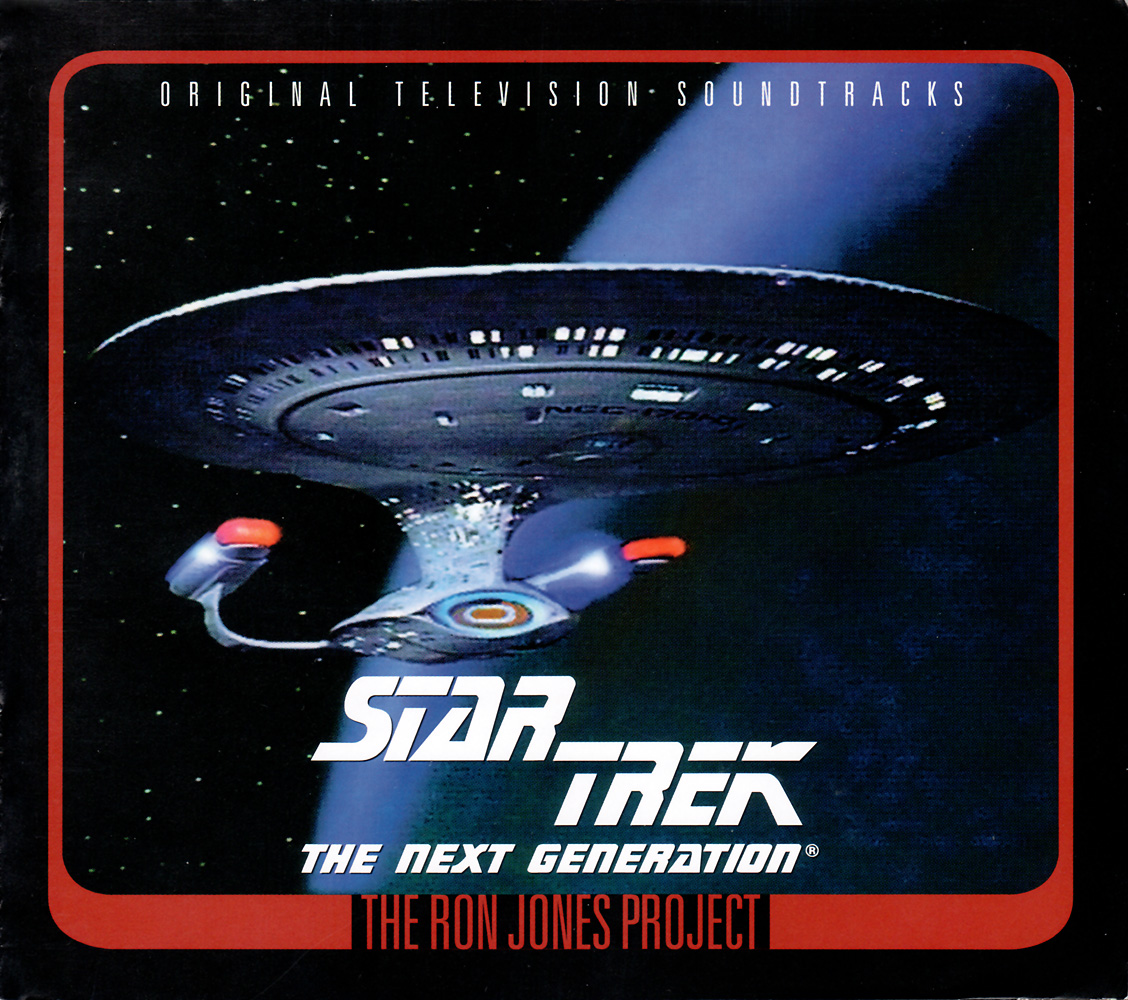
Star Trek: The Next Generation – The Ron Jones Project
Due to the much-longer-than-usual nature of this in-depth review, and in an attempt to save everyone’s sanity who isn’t interested, you’ll have to click on “more” below to read the full text.
In the summer and fall of 1990, fans of Star Trek: The Next Generation were in frothing-from-the-mouth overdrive: they were busily speculating about the conclusion of the best cliffhanger that TNG would ever produce, and obsessing over their freshly-recorded VHS tapes (remember those?) of the season finale. Repeated viewing of The Best Of Both Worlds Part I yielded numerous insights, namely that the show really had gotten that good, and that this Ron Jones guy who did the music for the episode was on fire. A year later – an agonizing lag compared to how quickly TV music seems to be released these days – GNP Crescendo gave the world the soundtrack to both parts of Best Of Both Worlds, landing themselves a legion of grateful fans and an award for the best indie label soundtrack release of the year.
Some of us, however, had been paying attention to the music credits for a long time, and Ron Jones had been on the radar of musically-aware fans since season one. The cruel irony, of course, is that 1991 also marked the end of Jones’ involvement with the Star Trek series, and the rest of the TNG music released by Crescendo was from composers Dennis McCarthy and Jones’ replacement, Jay Chattaway, both of whom remained with the franchise until Star Trek: Enterprise went off the air in 2005. Barring a short two-part suite of music from the season one Klingon episode Heart Of Glory on 1996’s Best Of Star Trek CD, and despite the fact that Jones had gone through his archives and presented Crescendo with enough material for Klingon and Romulan themed TNG soundtrack collections, nothing else was forthcoming from TNG’s musical golden boy.
He still had fans, though, including yours truly, and including Film Score Monthly founder Lukas Kendall. As Film Score Monthly spawned a label and ultimately ceased to be a paper magazine, the idea of a Ron Jones TNG collection never went away. While even the most expectant fans might have bet on a CD here and there, nobody could’ve envisioned what Kendall had in mind: a 14 CD box set consisting of nearly every note Ron Jones composed and recorded for Star Trek: The Next Generation – in short, the full soundtrack for every episode Jones scored, not just the ones that everyone remembered well. With the possible exception of the (ultimately truncated) series of Babylon 5 episode scores on CD, nothing like this had been attempted for TV music.
He Will Have His Way: The Songs Of Tim and Neil Finn
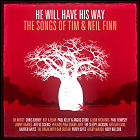 Right around the time the last Finn Brothers album came out (which has been too long ago, Tim and Neil), a tribute album appeared, recasting several Split Enz, Finn Brothers, Crowded House and Finn solo numbers with all-female (or mostly-female-with-female-vocalists) acts. It was an interesting exercise in how some of these songs could take on a completely different meaning depending on who was singing them to whom. (Some of the artists involved gender-switched the lyrics, and some performed the songs as written.) Now, several years later, we get to find out how the other half’s been living with an all-male tribute album.
Right around the time the last Finn Brothers album came out (which has been too long ago, Tim and Neil), a tribute album appeared, recasting several Split Enz, Finn Brothers, Crowded House and Finn solo numbers with all-female (or mostly-female-with-female-vocalists) acts. It was an interesting exercise in how some of these songs could take on a completely different meaning depending on who was singing them to whom. (Some of the artists involved gender-switched the lyrics, and some performed the songs as written.) Now, several years later, we get to find out how the other half’s been living with an all-male tribute album.
Given that all of the source material was originally performed by all-male groups of one kind or another, it seems like there’s something a little less challenging about the concept behind He Will Have His Way, but it’s at least interesting to hear what’s happened to the chosen songs in translation.
The most interesting reinterpretations are Boy & Bear’s version of “Fall At Your Feet”, which starts out sounding a bit ominous before gradually turning into a more traditional (but still oddly foreboding) band jam, and the very dialed-back, one-man-and-an-electric-guitar rendition of “Distant Sun” by Chris Cheney. “Better Be Home Soon” is heard in two very different forms here, a reading fairly close to the original (but decidedly country-fried) by Busby Marou and a glam dance floor groove by The Sleepy Jackson (an interesting style choice that seems to fly in the face of the song’s lyrics) with actually seems to ditch the tune of the original.
The Split Enz songs in the mix get some interesting twists, from the epic-jokey read of “Shark Attack” to Jimmy Barnes’ throat-ripping but pitch-perfect rendition of “Message To My Girl”. Perry Keyes’ stripped-down, rootsy version of the sci-fi-themed “Poor Boy” is surprisingly effective. Art vs. Science’s take on “I See Red” is slightly modernized, but not by much. Strangely, the Philadelphia Grand Jury cover of “I Got You” strips some of the catchiness out of the tune that finally propelled the Enz toward the top of the charts. The solo careers of the Finns wind up low on the priority list: Neil’s “Addicted” and Tim’s “Not Even Close” are the only solo songs covered here, with both cover versions staying close to home. The only Finn Brothers song proper is a raucous cover of “Kiss The Road Of Rarotonga”.
 As disconcerting as The Sleepy Jackson’s cover of “Better Be Home Soon” is, it’s a glimpse into something I would’ve appreciated hearing a bit more of here: some serious stylistic diversion from the original songs. She Will Have Her Way seemed to have a little more freedom here just because there was already enough of a culture shock with the all-female concept; He Will Have His Way hews too close to the originals in many cases. But everything is nicely done, and some of these acts have jumped toward the top of my “check out their other stuff” list.
As disconcerting as The Sleepy Jackson’s cover of “Better Be Home Soon” is, it’s a glimpse into something I would’ve appreciated hearing a bit more of here: some serious stylistic diversion from the original songs. She Will Have Her Way seemed to have a little more freedom here just because there was already enough of a culture shock with the all-female concept; He Will Have His Way hews too close to the originals in many cases. But everything is nicely done, and some of these acts have jumped toward the top of my “check out their other stuff” list.
- I Feel Possessed performed by Oh Mercy (3:15)
- Distant Sun performed by Chris Cheney (3:29)
- Fall At Your Feet performed by Boy & Bear (4:31)
- Four Seasons In One Day performed by Paul Kelly & Angus Stone (4:18)
- She Got Body, She Got Soul performed by Glenn Richards (3:02)
- Addicted performed by Paul Dempsey (4:09)
- Message To My Girl performed by Jimmy Barnes (4:34)
- I See Red performed by Art vs. Science (4:01)
- I Got You performed by Philadelphia Grand Jury (3:12)
- Better Be Home Soon performed by The Sleepy Jackson (4:35)
- Private Universe performed by Artisan Guns (4:15)
- Not Even Close performed by Darren Hayes (4:06)
- Shark Attack performed by The Break with Dan Sultan (4:32)
- Poor Boy performed by Perry Keyes (3:49)
- Better Be Home Soon performed by Busby Marou (3:49)
- Kiss The Road Of Rarotonga performed by Kody Nelson (3:11)
Released by: EMI
Release date: 2010
Total running time: 62:48
Space Battleship Yamato
 Where last year saw the release of the first animated extension of the venerable Space Battleship Yamato anime franchise in many years, late 2010 saw the release of the first ever attempt to do Yamato – better known to English speaking audiences as Star Blazers – on the big screen in live action. Though there have been tantalizing glimpses from video games over the years that hinted at CGI being ready to depict the Yamato’s endless devastating battles and ground-rattling launches, talk of Yamato or Star Blazers in live action form had, up until now, been nothing more than talk.
Where last year saw the release of the first animated extension of the venerable Space Battleship Yamato anime franchise in many years, late 2010 saw the release of the first ever attempt to do Yamato – better known to English speaking audiences as Star Blazers – on the big screen in live action. Though there have been tantalizing glimpses from video games over the years that hinted at CGI being ready to depict the Yamato’s endless devastating battles and ground-rattling launches, talk of Yamato or Star Blazers in live action form had, up until now, been nothing more than talk.
2009‘s animated Space Battleship Yamato: Rebirth Chapter‘s soundtrack revisited many of the key musical themes built up by the late, great Hiroshi Miyagawa and the composers who followed in his footsteps, and combined that music somewhat jarringly with numerous well-worn pieces from the world of classical music. Needless to say, many longtime fans were curious what the live-action film would do – would it refer to the original series’ music at all, or do something completely different?
As it happens, the answer lands somewhere between the two. Composer Naoki Sato reverently quotes several themes dating back to the first season of Yamato on TV (which aired in 1974), but arranges them for a huge orchestra and choir. These themes are interspersed with completely new material seamlessly, and the whole thing plays out on a grand scale – to put it mildly, it’s majestic. “The Universe Spreading To Infinity” goes from a single female vocal to an entire choir, and eventually joins with snare drums to become a funeral dirge (probably for Admiral Okita, assuming this movie is following the Quest for Iscandar plot and condensing it into two hours). The Yamato theme is also quoted in its entirety numerous times, and bits of it are quoted for flavoring throughout. If the production design’s obvious reverence to the original vehicles, uniforms and character “looks” of the original series isn’t enough of a stamp of authenticity, then the music certainly is.
The new musical material is worthy of sitting alongside the classic Yamato themes, too, and they bring the whole thing right up to date. “Gamilus” is clear that the slurring-brass sound of Michael Giacchino‘s music from Lost has survived translation across the Pacific, and “Enemy Fleet Disappearance” is a suspenseful piece of mysterioso music that begs comparison with selections from John Williams‘ music from Star Wars. Being compared to such things is not a bad thing.
 Naoki Sato wisely chose to come storming out of the gates with Space Battleship Yamato, and the result is an addictively listenable soundtrack. Now someone needs to hurry up and bring the movie to these shores so we can see how good the rest of the package is.
Naoki Sato wisely chose to come storming out of the gates with Space Battleship Yamato, and the result is an addictively listenable soundtrack. Now someone needs to hurry up and bring the movie to these shores so we can see how good the rest of the package is.
- Space Battleship Yamato Opening Title (3:36)
- The Man Who Became Thin (1:16)
- Desired Vessel (4:18)
- Wave Motion Gun Discharge (4:40)
- Gamilus Fleet (3:27)
- Return (2:45)
- Gamilus (0:48)
- Orders (1:40)
- Enemy Fleet Disappearance (3:22)
- An Instant Of Calm (4:25)
- Consolation (1:42)
- Beautiful Blue Star (0:49)
- Crisis (2:15)
- Belief (2:12)
- New History (2:28)
- Cosmo Zero Takeoff (4:38)
- Truth Of Radioactivity Removal Device (5:53)
- Entrusting The Future (2:07)
- Earth (2:36)
- Desslar’s Retaliation (3:23)
- Those We Protect (4:43)
- Final Salute (3:07)
Released by: Crown Tokuma
Release date: 2010
Total running time: 66:10
Krull
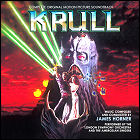 Announced just prior to (and available at) the 2010 San Diego Comic Con, this long-overdue remastered (and, this time, officially-licensed and above-board) edition of the Krull soundtrack is practically custom-made for Comic Con – it’s such an obscure, cult-following niche item that only a Comic Con attendee or Krull‘s own mother could love it.
Announced just prior to (and available at) the 2010 San Diego Comic Con, this long-overdue remastered (and, this time, officially-licensed and above-board) edition of the Krull soundtrack is practically custom-made for Comic Con – it’s such an obscure, cult-following niche item that only a Comic Con attendee or Krull‘s own mother could love it.
As hard as I ride the familiar horse that virtually everything James Horner composed in the 80s had the DNA of his score for Star Trek II in it, Krull at last pushes the familiar chords and progressions into a more fantastical, sword-and-sorcery realm. The movie itself was one of numerous cinematic attempts to marry SF and swashbuckling fantasy in the wake of Star Wars, though Krull made the mashup more literal than most, with more traditional feudal elements jostling for screen time with sci-fi concepts. Despite a merchandising blitz, it wound up with a cult audience and little more.
And up until La-La Land’s nicely cleaned-up 2010 two-disc soundtrack release, that cult audience had to make do with the (now insanely rare and expensive) pressing of the Krull score from the defunct Supertracks label. Supertracks was a ’90s outfit, also known for having turned out the only CD release of the music from the Paul McGann Doctor Who movie, that operated on a slightly shady basis: composers needed promotional copies of their work could get them pressed by Supertracks, but in exchange, they would quietly look the other way while Supertracks also sold copies of the same albums to soundtrack collectors. Though frequently sporting fine cover artwork and booklets, Supertracks’ releases were seldom, if ever, officially licensed. Supertracks suddenly disappeared early in the 2000s, and one doesn’t have to be a rocket scientist to connect the dots. Krull – and everything else produced by Supertracks – went out of print overnight and became collectors’ items.
La-La Land snatched up the rights to an official Krull soundtrack, fortuitously timed to both Comic Con and the DVD and Blu Ray release of Krull. The track list is largely the same as the Supertracks edition, but it sounds much better – the  difference in sonic quality is considerable. There’s also a specially-edited “Theme From Krull” suite assembled by the album producers from portions of the opening and credits.
difference in sonic quality is considerable. There’s also a specially-edited “Theme From Krull” suite assembled by the album producers from portions of the opening and credits.
Though this edition is also, as far as the label is concerned, sold out of its edition of 3000 copies, but let’s look on the sunny side: there are 3,000 fresh copies out there with better sound quality than the old release that was all but a bootleg. Krull‘s worth revisiting, and this time you just might be able to afford it.
Disc One
- Main Title And Colwyn’s Arrival (7:34)
- The Slayers Attack (9:18)
- Quest For The Glaive (7:23)
- Ride To The Waterfall (0:53)
- Lyssa In The Fortress (1:28)
- The Walk To The Seer’s Cave (4:10)
- The Seer’s Vision (2:18)
- The Battle In The Swamp (2:39)
- Quicksand (3:38)
- The Changeling (4:04)
- Leaving The Swamp (1:58)
Disc Two
- Vella (3:46)
- The Widow’s Web (6:18)
- The Widow’s Lullaby (5:01)
- Ynyr’s Death (1:41)
- Ride Of The Firemares (5:22)
- Battle On The Parapets (2:53)
- Inside The Black Fortress (6:13)
- The Death Of The Beast And The Destruction Of The Black Fortress (8:31)
- Epilogue And End Title (4:52)
- Colwyn And Lyssa Love Theme (2:35)
- The Walk To The Seer’s Cave – album edit (2:16)
- Theme From Krull (4:48)
Released by: La-La Land Records
Release date: 2010
Disc one total running time: 45:23
Disc two total running time: 54:16

Star Trek V: The Final Frontier (Newly Expanded Edition)
Released with little advance warning or fanfare at the end of 2010, Jerry Goldsmith‘s soundtrack from Star Trek V: The Final Frontier is the archetypal “soundtrack that’s ripe for an expanded re-release” – it’s better music than its parent movie deserved, only a certain amount of the music has been available before (namely, a 45-minute soundtrack album that dates back to the twilight of the vinyl LP), and it pleases followers of both the Star Trek franchise and the late, great composer himself. Seriously, what’s not to love about this release?
The previously unreleased slices of Goldsmith’s soundtrack are, partly because of obscurity and partly because of quality, much more interesting than the stuff we have heard before. What we’ve been missing out on for over 20 years is material that clarifies the development of many of the movie’s musical themes: the unstable-but-noble Sybok theme, material both uncertain and religious/epic for his quest to find God, and lots of interesting new uses of Goldsmith’s by-now well-worn Star Trek: The Motion Picture Enterprise and Klingon themes (remember that, when this movie was released, that material had also been quoted and/or rearranged extensively for two seasons of Star Trek: The Next Generation). That Goldsmith reclaims his material and puts a fresh spin on it is impressive.
There’s also much more of an adventurous, emotional feel to those themes this time around, rather than the somewhat unemotional treatment of the same material in his score for the first Star Trek movie (though that movie’s colder, more intellectual nature demanded the musical treatment that it received). If there’s one area where the music from Star Trek V falters even slightly, it’s some of the electronic instrumentation, especially a recurring, off-kilter motif for Sybok and his movement. Goldsmith is often hailed for his innovative use of electronics and his ability to make them part of the orchestra rather than making them sound like an oddball overdub, but by this point synths and electronic keyboards were off-the-shelf instruments with a somewhat limited palette of preset sounds. There’s an interesting synthesized “drone” for Sybok’s repeated demonstration of an ability to probe other characters’ pain, but other than that, nothing stands out like, say, Goldsmith’s use of analog synths in Logan’s Run or the unearthly Blaster Beam sound of Star Trek: The Motion Picture.
Unlike every other ’80s Star Trek soundtrack released in the past couple of years, Star Trek V was released by La-La Land Records, but in a collaboration of soundtrack boutique label all-stars, still sports an incredibly informative booklet by Film Score Monthly’s Lukas Kendall and Jeff Bond (the latter of whom wrote an entire chapter on the Trek V soundtrack in his book “The Music Of Star Trek“), so it’s still very consistent with the packaging and presentation of FSM’s other Trek music releases from 2010. And as with Film Score Monthly’s previous reissues of music from Star Trek II and Star Trek III, the second disc of this soundtrack replicates the original 1989 soundtrack album (and there are actually some differences between the album versions and film versions of some pieces), and uses the remaining run time of the second disc for alternates, early takes and a track of electronic “experiments.”
Hearing the music afresh raised my opinion of the soundtrack from Star Trek V considerably, and I almost  found myself wondering if perhaps the movie itself hasn’t gotten a bit of a bum rap, what with its plotline about a madman in a desert trying to manipulate a more powerful body (the Federation, by way of the Enterprise) in his quest to appease his god. With music like this, it’s almost enough to make one consider a rematch with the movie itself.
found myself wondering if perhaps the movie itself hasn’t gotten a bit of a bum rap, what with its plotline about a madman in a desert trying to manipulate a more powerful body (the Federation, by way of the Enterprise) in his quest to appease his god. With music like this, it’s almost enough to make one consider a rematch with the movie itself.
Disc 1 – The Complete Film Score
- Nimbus III (2:01)
- The Mind-Meld (2:43)
- The Mountain [Main Title] (4:53)
- The Big Drop (0:26)
- Raid on Paradise (2:43)
- Not Alone (1:11)
- Target Practice (1:52)
- A Tall Ship (1:43)
- Plot Course (1:46)
- No Harm (2:13)
- Approaching Nimbus III (2:59)
- Open the Gates (3:01)
- Well Done (1:16)
- Without Help (4:55)
- Pick It Up (2:31)
- No Authority (0:30)
- It Exists (1:47)
- Free Minds (3:18)
- The Birth (3:53)
- The Barrier (2:52)
- A Busy Man (4:41)
- An Angry God (6:57)
- Let’s Get Out of Here [part 1] (3:42)
- Let’s Get Out of Here [part 2] (3:07)
- Cosmic Thoughts (1:16)
- Life Is a Dream [End Credits] (3:57)
Disc 2 – The 1989 Soundtrack Album
- The Mountain (3:50)
- The Barrier (2:51)
- Without Help (4:18)
- A Busy Man (4:40)
- Open the Gates (3:00)
- An Angry God (6:55)
- Let’s Get Out of Here (5:13)
- Free Minds (3:17)
- Life Is a Dream (3:57)
- The Moon’s a Window to Heaven – performed by Hiroshima (4:00)
Additional Music
- The Mountain (alternate) (4:45)
- A Busy Man (alternate) (4:42)
- Paradise Saloon (source) (2:42)
- The Moon’s a Window to Heaven (film version) (1:10)
- Vulcan Song / Row, Row, Row Your Boat (instrumental source) (1:33)
- Synclavier Effects (1:54)
Released by: La-La Land Records
Release date: 2010
Disc one total running time: 73:07
Disc two total running time: 59:28
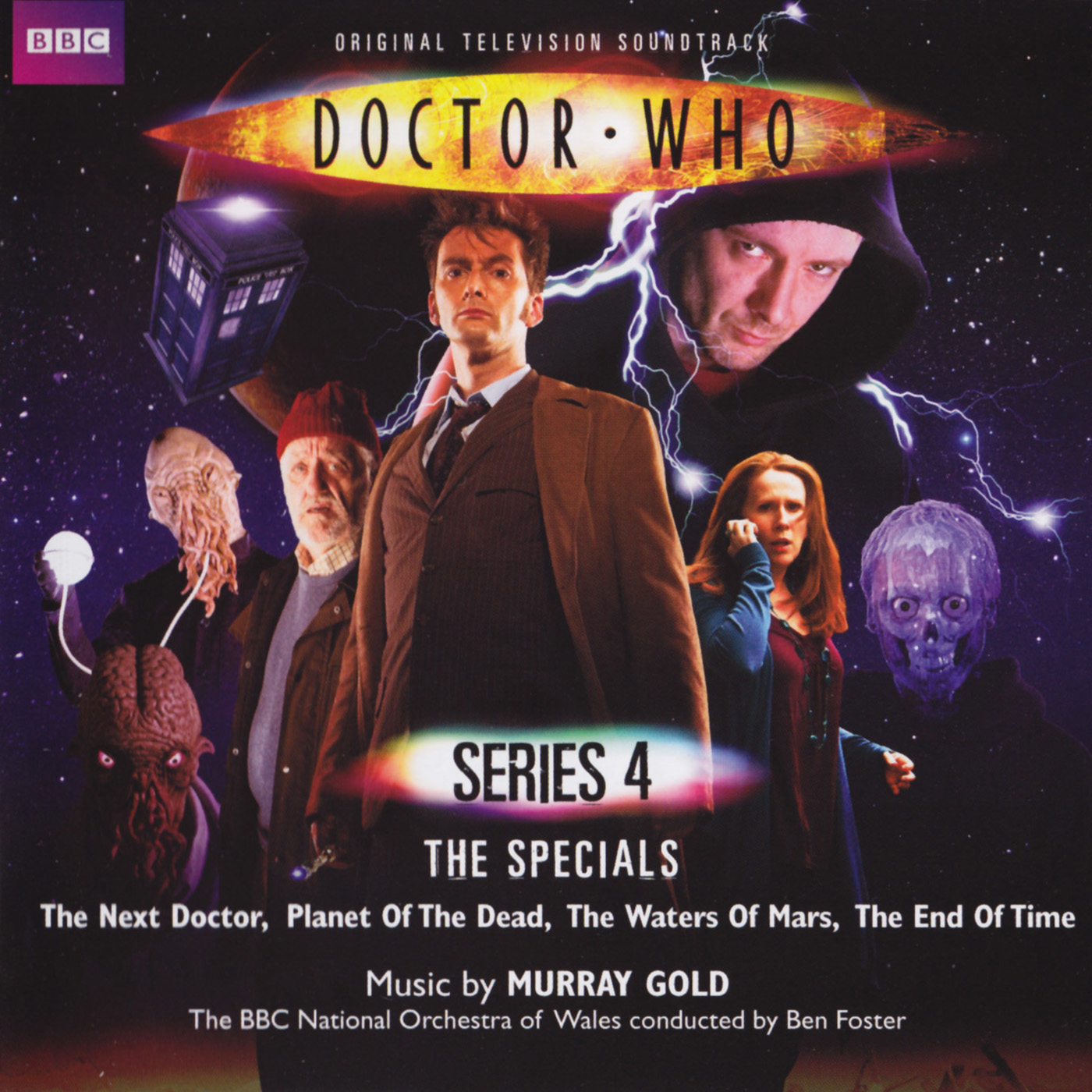
Doctor Who: Series 4 – The Specials
Released purely by popular demand (a fan campaign that was, admittedly, egged on by composer Murray Gold), this 2-CD set of music from David Tennant’s final Doctor Who episodes is quite different from the collections of Gold’s music that have been released before. Previous Doctor Who CDs from the new series have featured short suites of music from given episodes and, in a few cases, complete cues from particularly high-profile scenes. Doctor Who: Series 4 – The Specials presents almost all of its material as discrete cues rather than edited highlights.
Since modern Doctor Who relies to a certain extent on a “library music” approach – certain pieces of music recorded for earlier episodes in a given season frequently recur throughout that season – some episodes are more heavily represented than others. In the case of the Series 4 – The Specials soundtrack, the episodes that drew the short straw – because they leaned heavily on existing music – are Planet Of The Dead and The Waters Of Mars. As these are generally regarded to be the weak points in the tenth Doctor’s finaladventures, this probably won’t meet with too many howls of protest.
Represented much more fully are The Next Doctor (the 2008 Christmas special) and both episodes of The End Of Time, a two-parter that wrapped up the tenth Doctor’s story. The Next Doctor actually has a rather Christmassy feel to it, and it reinterprets some of Gold’s previous Cybermen music from Rise Of The Cybermen and The Age Of Steel. This is typical Murray Gold: a bit overblown, like a student of John Williams set loose in a candy shop, but a lot of fun.
Somewhat more interesting is the lengthy selection of music from The End Of Time, which has a much heavier, more doom-laden feel to it; whereas The Next Doctor‘s title was a red herring, The End Of Time makes good on its promise to end the tenth Doctor’s story and introduce the Time Lord’s eleventh incarnation. From the beginning, The End Of Time is painted in shades of epic, with an abundance of choral pieces and less jubilant music than a typical Murray Gold Doctor Who outing. Highlights include the scenes set on Gallifrey during the Time War, and a new suite of music expanding the “four knocks” motif from the Master’s previous appearance at the end of series three. Even casual listeners will probably zoom straight forward to “Vale Decem”, the choral piece that sees Tennant’s Doctor out of the Doctor Who mythos. (A prelude to this piece, “Vale”, opens and closes the whole collection.) The energetic, rock-oriented “The New Doctor” gives us our first glimpse of the eleventh Doctor in action – but for more of him, there’s a whole different soundtrack.
Even the music from The End Of Time isn’t all new – the disappearance of Gallifrey back into its rightful (and doomed) place in time isn’t included here, having been tracked with music from the fourth season episode Midnight (already available on that season’s soundtrack). Also, there are two iTunes-exclusive tracks – one from The End Of Time and one from The Next Doctor – which owners of the physical 2-CD set would have to buy the entire thing all over again, this time in digital form, to get. (As a general rule, this kind of exclusivity annoys the hell out of me: digital delivery has killed the brick-and-mortal music store already. Further incentives to abandon physical media are, quite simply, no longer necessary. Put the same material on both formats and let consumers make up their own minds, as those still buying CDs are most likely doing so for reasons that won’t be overridden by two extra tracks.)
It almost seems as though The Waters Of Mars gets shortchanged here, as its very scary, drippy-liquidy music comes and goes all too briefly; I would’ve traded some of The Next Doctor‘s music in for more Waters.
 Overall, it’s a nice musical chronicle of David Tennant’s extended swan song as the Doctor, and should more than satisfy fans who are looking for any particularly memorable scene from his final episodes. The change from “brief suites covering much of the season” to “mostly unedited full cues straight off the master tapes” is a bit of a gear shift that’ll take some getting used to.
Overall, it’s a nice musical chronicle of David Tennant’s extended swan song as the Doctor, and should more than satisfy fans who are looking for any particularly memorable scene from his final episodes. The change from “brief suites covering much of the season” to “mostly unedited full cues straight off the master tapes” is a bit of a gear shift that’ll take some getting used to.
Disc One
- Vale (1:37)
The Next Doctor
- A Victorian Christmas (1:34)
- Not the Doctor (3:19)
- A Bit of a Drag (1:23)
- In the Sea of Memory (0:44)
- Hidden in the Closet (1:51)
- The Wonder of Balloons (1:23)
- A Forceful Intelligence (1:12)
- The Greats of Past Time (5:04)
- The March of the Cybermen (4:13)
- Goodbyes (5:04)
Planet of the Dead
- A Disturbance in the Night (0:38)
- The Cat Burglar (1:30)
- Alone in the Desert (3:19)
- A Special Sort of Bus (2:19)
- Stirring in the Sands (1:58)
- Lithuania (1:48)
The Waters of Mars
- Letter to Earth (2:15)
- By Water Borne (2:23)
- The Fate of Little Adelaide (5:05)
- Altering Lives (3:23)
Disc Two
The End of Time- We Shall Fare Well (1:26)
- A Frosty Ood (2:50)
- A Dream of Catastrophe (1:18)
- All in the Balance (0:55)
- A Ruined Gaol (1:22)
- Wilf’s Wiggle (0:43)
- Minnie Hooper (1:31)
- The End Draws Near (3:46)
- Gallifrey (2:22)
- Final Days (1:43)
- The Council of the Time Lords (0:41)
- The Master Suite (4:33)
- The Ruined Childhood (3:27)
- A Chaotic Escape (2:59)
- The World Waits (5:18)
- A Longing to Leave (1:18)
- A Lot of Life Behind Us (4:20)
- Dealing with the Menace (1:35)
- Speeding to Earth (1:18)
- The Time Lords’ Last Stand (3:27)
- The Clouds Pass (1:53)
- Four Knocks (4:04)
- Song for Ten (Reprise) (2:21)
- Vale Decem (3:19)
- Vale (4:20)
- The New Doctor (1:07)
Released by: Silva Screen
Release date: 2010
Disc one total running time: 52:02
Disc two total running time: 64:06
Tron Legacy (North American edition)
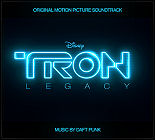 One of the things announced fairly early on about Tron Legacy was that its music would be composed by Daft Punk. Now, I like “Robot Rock” as much as the next guy, but was this French techno/DJ duo up to composing the score for an entire film from a franchise whose fan base was very much attached to the synth-orchestral sound of the original movie?
One of the things announced fairly early on about Tron Legacy was that its music would be composed by Daft Punk. Now, I like “Robot Rock” as much as the next guy, but was this French techno/DJ duo up to composing the score for an entire film from a franchise whose fan base was very much attached to the synth-orchestral sound of the original movie?
As it turns out, Daft Punk was more than up to the challenge, and more than a few moviegoers are likely to snap up the soundtrack while quietly asking themselves “Who did the music to the original Tron? Carlos somebody?” Just as Wendy Carlos‘ expansive, at times almost abstract electronic music was a perfect fit for the original Tron, Daft Punk nails the sound that accompanies the new movie. It’s a giddy mix of synth and orchestral textures, with only a couple of tracks that hint at Daft Punk’s more typical sound. It’s a much more foreboding sound than Carlos’ music, which did a great job of establishing Tron‘s computer world as a wondrous, almost magical setting. The new movie’s setting is darker and more dangerous, and Daft Punk’s music is a perfect fit for that.
But you don’t just hear Daft Punk on the soundtrack – there’s also an orchestra of over 100 players here, and the CD credits make a note of an orchestration assist by veteran Hollywood composer Bruce Broughton – normally a name you see headlining his own soundtracks. There are also “special thanks” for advice on the art of film scoring listing names like Harry Gregson-Williams and Hans Zimmer (again, not exactly B-list names). Daft Punk chased after this assignment, admitting along the way to being fans of classic Tron, and they obviously also sought some help from some of the most prolific film composers in the business.
The result is a soundtrack with plenty of motifs for specific characters and situations, and an album that, while it isn’t necessarily in the chronological order of scenes in the movie, makes for a very satisfying listen. Helping things considerably is that the movie’s rookie director (at least as far as directing for the big screen goes) trusted his rookie composers enough to dial the film’s atmospheric sound mix back and let the music carry key moments. One of the best musical moments in the score – a piece that’s been getting rapt attention as far back as the movie’s trailers – is “The Game Has Changed”, but its quiet, moody intro lands on an unusually quiet moment at the beginning of the showy (and otherwise noisy) light cycle competition. It’s a surprising combination of scene and music, and it’s incredibly effective.
The closest Daft Punk gets to sounding like Wendy Carlos may be the mostly-electronic “Son Of Flynn”, which somewhat surprisingly accompanies scenes that take place in the “real” world rather than the electronic realm. Other highlights include “Nocturne” (a much more sedate take on the same basic melody as “Son Of Flynn”), the techno anthem “Derezzed”, “Rinzler” and another moment where the music dominates the movie’s sound mix, “Adagio For Tron”. Those pieces that are mostly orchestral are surprisingly good – not a bad film scoring debut for a couple of guys whose primary output is electronic dance music.
There is one big bone to pick, but it isn’t with Daft Punk. Listeners in the UK and Europe got a two-disc version of the Tron Legacy soundtrack with several extra tracks, and even more extra tracks were spread out among online music stores ranging from iTunes and Amazon.com to Wal-Mart and Nokia (!). The scavenger hunt approach might have been neat for the “Flynn Lives” alternate reality game that helped to build buzz leading up to the movie’s release, but don’t make it such a chore for us to get a complete soundtrack for the movie. The additional tracks will be covered in another review.
As a single-CD experience, however, the Tron Legacy soundtrack delivers most of the movie’s key scenes in musical form. I really don’t know if this score hails the beginning of a whole new career for Daft Punk, or just a brilliant way to get a new audience interested in their back catalogue and future works, but I would bet money on one thing:  Tron Legacy‘s soundtrack will become a frequent flyer in movie trailers for the next decade. Its dark ambience and rhythmic sense make for some pretty catchy music, either with or away from the movie for which the music was originally constructed. And that, naturally, makes it a pretty good soundtrack listen too.
Tron Legacy‘s soundtrack will become a frequent flyer in movie trailers for the next decade. Its dark ambience and rhythmic sense make for some pretty catchy music, either with or away from the movie for which the music was originally constructed. And that, naturally, makes it a pretty good soundtrack listen too.
- Overture (2:28)
- The Grid (1:36)
- The Son of Flynn (1:35)
- Recognizer (2:37)
- Armory (2:03)
- Arena (1:33)
- Rinzler (2:17)
- The Game Has Changed (3:25)
- Outlands (2:42)
- Adagio for TRON (4:11)
- Nocturne (1:41)
- End of Line (2:36)
- Derezzed (1:44)
- Fall (1:22)
- Solar Sailer (2:42)
- Rectifier (2:14)
- Disc Wars (4:11)
- C.L.U. (4:39)
- Arrival (2:00)
- Flynn Lives (3:22)
- TRON Legacy (End Titles) (3:17)
- Finale (4:22)
Released by: Disney Music
Release date: 2010
Total running time:
Art Of Noise – Influence: Best Of The Art Of Noise
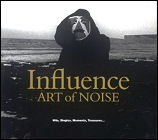 A while back, this site reviewed a 4-disc Art Of Noise box set, And What Have You Done With My Body, God?, which spent its entire running time on the group’s first EP and first full-length album, and the various detours that led them there, in essence rehashing the same handful of songs in subtly different evolutionary stages over the entire running time of 4 CDs. It’s a very strange thing to think that, for an encore, we now get Influence, a mere 2-CD set which spans the group’s entire career.
A while back, this site reviewed a 4-disc Art Of Noise box set, And What Have You Done With My Body, God?, which spent its entire running time on the group’s first EP and first full-length album, and the various detours that led them there, in essence rehashing the same handful of songs in subtly different evolutionary stages over the entire running time of 4 CDs. It’s a very strange thing to think that, for an encore, we now get Influence, a mere 2-CD set which spans the group’s entire career.
What’s more, Influence rolls out some mixes that I haven’t heard before: a stand-alone single version of “Legs” that wraps up within its own style rather than crashing abruptly into the next song on its original album, a very different mix of “Paranoimia” (but still with Matt “Max Headroom” Frewer vocals), and so on. In other words, unlike a best-of album that rehashes what you’ve heard, it gives you some slightly different takes on the familiar expected hits and near-misses (and, atypically for an Art Of Noise retrospective, The Seduction of Claude Debussy is very well represented, though we barely hear anything from the album Below The Waste). There are also a great many things here that I’ve never heard before: TV theme songs, ad jingles, and other oddities. There’s also an intriguing track called “Something Missing” that hints at different creative directions that may have been under consideration for what became the Claude Debussy album.
If there’s a disappointment with Influence, it’s the fact that the career-spanning collection wasn’t given the 4-disc breathing room that And What Have You Done With My Body, God? was; that earlier box set was a bit of a masturbatory exercise in lamenting what plans Trevor Horn and Paul Morley originally had for Art Of Noise (which also seemed to be the point of the much earlier – and appropriately titled – Daft compilation…okay, guys, we get it). Influence deserved at least equal space, simply because Art Of Noise, at all points in its history, is worth a retrospective that truly has some scope. The two discs that are there, however, are hugely enjoyable and highly recommended – to  this day, the Art Of Noise in its various incarnations simply do not get their due for changing the course of electronic music, opening up the eyes of both the listening public and fellow musicians to the possibilities offered by the then-approaching age of sampling real world sounds, both musical and non-musical in origin, to build songs out of.
this day, the Art Of Noise in its various incarnations simply do not get their due for changing the course of electronic music, opening up the eyes of both the listening public and fellow musicians to the possibilities offered by the then-approaching age of sampling real world sounds, both musical and non-musical in origin, to build songs out of.
Disc One
- A Is For Beginning (2:02)
- Moments In Love (4:39)
- Beat Box (Diversion) (3:59)
- Close (To The Edit) (4:11)
- Love Beat (5:15)
- Promenade One (0:36)
- Legs (3:30)
- Peter Gunn (featuring Duane Eddy) (3:58)
- Paranoimia (Paranoid Mix) (featuring Max Headroom) (6:33)
- Dragnet (Art Of Noise 7″ mix) (3:04)
- Promenade Two (0:40)
- Ode To Don Jose (4:14)
- Acton Art (2:51)
- The Krypton Factor Theme (0:52)
- Kiss (featuring Tom Jones) (3:32)
- Finale (2:40)
- Metaforce (5:46)
- Something Is Missing (5:21)
- The Holy Egoism Of Genius (7:59)
- Bonus Track (2:32)
Disc Two
- Interlude One (0:15)
- Beep Beep (3:57)
- Beat Box (4:43)
- A Time For Fear (J.J.’s 12″ mix) (4:07)
- Dainty (1:44)
- Moments In Love (Anne To Tears Mix) (3:52)
- Moments In Love (Monitor Mix) (featuring Lucky Gordon) (2:09)
- Interlude Two (featuring Lucky Gordon) (0:17)
- This Is Your Life (1:59)
- This Is Your Life (4:35)
- I’m A Stranger Here Myself (5:22)
- Cassandra (6:03)
- Interlude Three (1:32)
- Dr. Gradus (1:12)
- Dreaming In Colour (via Way Out West) (6:46)
- On Being Blue (New Mix) (5:48)
- Beau Soir (2:51)
- Balance (3:18)
- Dr. Gradus (1:01)
- The Invention Of Love (2:50)
- Bonus Track (1:47)
Released by: Salvo
Release date: 2010
Disc one total running time: 74:14
Disc two total running time: 66:08
Homemade Spaceship: The Music Of ELO Performed By P. Hux
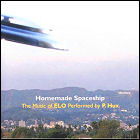 There’s gonna be a throwdown! At least that was what I thought when I first heard of this release: Parthenon Huxley, the songwriter, singer and multi-instrumentalist behind the excellent No Rewind album from The Orchestra (formerly ELO Part II), tries on some bona fide Jeff Lynne classics for size. Given ELO Part II/The Orchestra’s storied legal history with Lynne, surely Huxley had some massive brass balls. Not only had he become one of the inheritors of the ELO sound, but he was taking on classic ELO songs written by one of the group’s founders. A gutsy move, to say the very least.
There’s gonna be a throwdown! At least that was what I thought when I first heard of this release: Parthenon Huxley, the songwriter, singer and multi-instrumentalist behind the excellent No Rewind album from The Orchestra (formerly ELO Part II), tries on some bona fide Jeff Lynne classics for size. Given ELO Part II/The Orchestra’s storied legal history with Lynne, surely Huxley had some massive brass balls. Not only had he become one of the inheritors of the ELO sound, but he was taking on classic ELO songs written by one of the group’s founders. A gutsy move, to say the very least.
Huxley is, like many modern power pop practitioners, an admirer of Jeff Lynne’s songwriting and production acumen, and so perhaps it was wise for him to do something really unexpected with Homemade Spaceship: in many cases, he almost rewrites the music. Same words, but completely different takes on some of the familiar melodies. There are plenty of hints of the familiar melody of “Mr. Blue Sky”, for instance, but the timing has changed, and Huxley completely changes the trajectory of the main vocal melody. The lush harmonies are gone for the most part too, further confusing the ear that’s accustomed to Lynne’s wall of sound.
Some songs stick very close to their source material: “10538 Overture” is a folkier take on the very first ELO song, and has the added benefit of making the lyrics easier to understand than the original does. The closest any of the tracks here comes to their inspiration is “The Diary Of Horace Wimp”, which is presented in a laid-back way but, unlike many of the songs covered on Homemade Spaceship, preserves much of the harmonies in the chorus. “Showdown” stays close to the original, but trades in the original recording’s layers of foreboding strings for a pared-down, folky western dirge.
Some of the songs that do stray further from the source material are real treats: Huxley makes “Evil Woman” his own via some melodic twists and turns that differ significantly from the original, but it still has a driving beat and a bluesy feel at its heart. “Ma-Ma-Ma Belle” is a much softer song than the hard-rocking original, but the changes give the same set of lyrics a compeltely different emotional angle.
 My one complaint about Homemade Spaceship is that, like L.E.O., Huxley chooses to parody “Don’t Bring Me Down” instead of doing a more straightforward cover of it. With a faux British accent, he turns it into a song that’s spoken instead of sung, and occasionally reduces it to a Pythonesque farce. After the rest of the album’s thoughtful deconstructions of numerous ELO favorites, this approach struck me as cheap and cheesy, but your mileage may vary. Overall, a very interesting collection – ELO ultra-purists need not apply.
My one complaint about Homemade Spaceship is that, like L.E.O., Huxley chooses to parody “Don’t Bring Me Down” instead of doing a more straightforward cover of it. With a faux British accent, he turns it into a song that’s spoken instead of sung, and occasionally reduces it to a Pythonesque farce. After the rest of the album’s thoughtful deconstructions of numerous ELO favorites, this approach struck me as cheap and cheesy, but your mileage may vary. Overall, a very interesting collection – ELO ultra-purists need not apply.
- 10538 Overture (3:09)
- Mr. Blue Sky (4:08)
- Showdown (4:03)
- Can’t Get It Out Of My Head (4:22)
- Telephone Line (6:26)
- Sweet Talkin’ Woman (5:05)
- Evil Woman (4:54)
- Ma-Ma-Ma Belle (3:43)
- Strange Magic (3:41)
- The Diary Of Horace Wimp (5:13)
- Do Ya (4:08)
- Don’t Bring Me Down (3:34)
Released by: Reverberations
Release date: 2005
Total running time: 52:26
Rediscovering Lost Scores, Volume 2 – music by Wendy Carlos
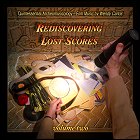 Film composer and synth innovator Wendy Carlos’ second disc of restored original score recordings focuses on her attempts to meld synthesizers and orchestral music in the 1970s and early 80s.
Film composer and synth innovator Wendy Carlos’ second disc of restored original score recordings focuses on her attempts to meld synthesizers and orchestral music in the 1970s and early 80s.
The second in a series of releases of “recovered” movie scores from Wendy/Walter Carlos’ library, this disc focuses on collaborations (and sometimes, collisions) between synthesizer and orchestra. Carlos provides her own liner notes both on the music itself and on the painstaking process of recovering it from the damaged master tapes upon which it had originally been recorded, which involved literally baking each reel of tape (quite literally in an oven) at a precise temperature for a precise amount of time; it wasn’t a process where you could put something back in the oven, either – there was one shot at getitng it right and preserving the original material. That same procedure allowed the composer to recover her original master tapes in time for the 20th anniversary release of the Tron score, and so it’s somehow appropriate that more music from Tron – both previously released and previously unreleased – can be heard here, along with music from equally iconic films.
Feel free to call me predictable, but of course what drew me to this volume (not having bought the first CD) was, naturally, the promise of new music from Tron. Fair warning: if that’s the only reason you’re thinking about getting this disc, maybe you should think twice. There isn’t a huge amount of new material presented here for the Tron fanatic, and a goodly chunk of it has been heard before: “Lightcycle Battle” was made available on the 20th anniversary edition DVD, and “Trinitron” – a.k.a. that part of the end credits that was covered up by Journey’s “Only Solutions” – has always been available as part of the end credit suite on the soundtrack releases, going all the way back to the 1982 LP release. (In the liner notes, Carlos makes it sound like this is the first time anyone’s ever heard it. Nope. It’s been my favorite piece of Tron music for 28 years running now!) The various other short tracks, which didn’t even make it into the movie, are interesting to hear…but they’re so short. It’s nice to have track-by-track liner notes for them though.
The material from The Shining, I barely remember, having seen that movie very few times (as opposed to having seen Tron about a zillion times); what I can tell you is that it sounds as sharp as the remastered Tron material, apparently baked to perfection. There’s also a healthy sampling of material from Carlos’ soundtrack to a movie I’ve never heard of, called Woundings.
Included as a couple of bonus tracks are two test tracks Carlos assembled for Dolby Laboratories, and they’re vintage Carlos material –  making use of very Bach-like counterpoint in the synth realm, and throwing in just one or two small musical in-jokes (i.e. “That’s all folks!”).
making use of very Bach-like counterpoint in the synth realm, and throwing in just one or two small musical in-jokes (i.e. “That’s all folks!”).
The second volume of Rediscovering Lost Scores is a nice cross-section of Carlos’ movie material, but it’s really not an entry-level album – this one is definitely for listeners who are either already fans of Carlos’ work, or of the movies whose music is included.
The Shining
- Shining Title Music (3:54)
- Paraphrase For ‘Cello (3:26)
- Where’s Jack? (5:24)
- The Overlook (3:57)
- Psychic Scream (1:29)
- Day Of Wrath (1:07)
- Paraphrase For Brass (1:37)
- Title Music ‘Dies’ (3:46)
- Clockworks ‘Dies’ (2:23)
Tron
- Creation Of Tron Vol. I (0:36)
- Creation Of Tron Vol. II (0:36)
- Lightcycle Games (2:06)
- Anthem (Studio Version) (1:24)
- Little Interludes (0:56)
- Trinitron (2:19)
Split Second
- Visit To A Morgue (1:24)
- Return To The Morgue (2:50)
Woundings
- Woundings Title Music (3:12)
- Angela’s Walk (1:05)
- Jimmy (1:38)
- Louise (0:56)
- Doug Does Angela (1:37)
- Scattering Ashes (1:33)
- Angela’s Aftermath (3:47)
- Jimmy Kills Louise (2:33)
- In A Cemetery (0:57)
- Fly Away And End (1:40)
Two Dolby Demos
- Jiffy Test: Bee Dee Bei Mir (1:25)
- Listen: Tannhauser (2:18)
Released by: East Side Digital
Release date: 2005
Total running time: 61:55
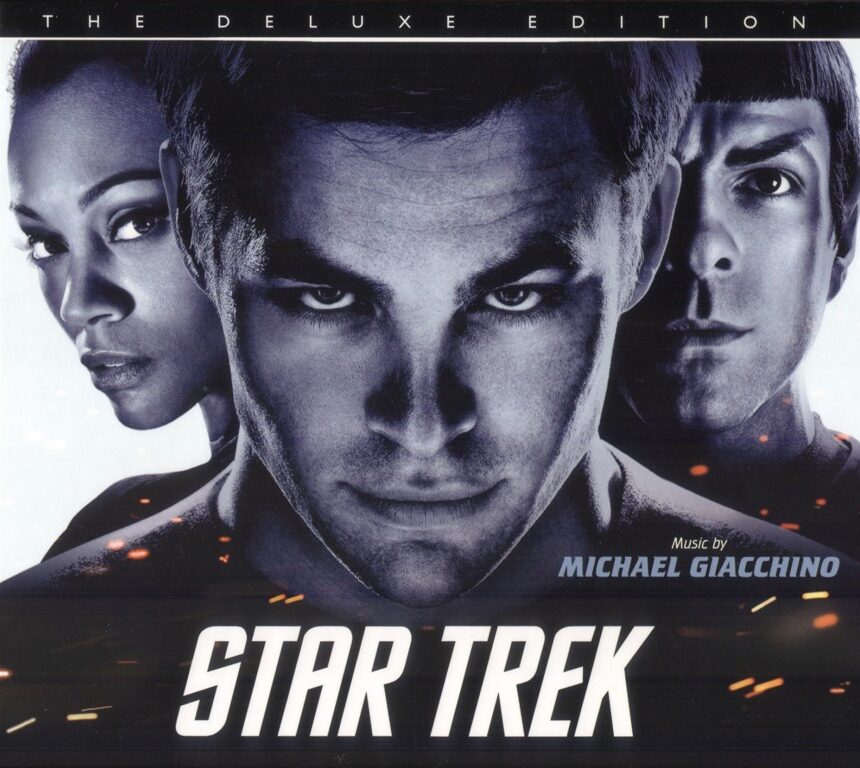
Star Trek (Newly Expanded Edition) – music by Michael Giacchino
Released to a combination of applause from Trek music completists and complaints of double-dipping from other observers, Varese Sarabande – not to be outdone by Film Score Monthly’s recent definitive editions of the music from Star Trek II and III – has now made the complete Michael Giacchino score from 2009’s Star Trek available as a swanky, limited-edition double-CD package (in, curiously, packaging normally used for two-disc Blu-Ray releases).
Is it worth going back to the well for every single note from the movie? Put simply and unequivocally: yes. Some of the best moments of the music from Star Trek were omitted from the single-CD soundtrack album that Varese issued at the time of the movie’s theatrical release. Those moments are restored in more or less chronological order here. I thought that both of the shuttlecraft rides to the Narada (Captain Robau’s and, later, Captain Pike’s) were awesomely menacing stuff, with enough harp to give the average John Williams score a run for its money, and those sequences can be found here. The thrilling orbital skydive to Nero’s drilling platform – a major action setpiece that was curiously left off of the original soundtrack album – is a piece of music likely to keep the fans happy.
Some of the best tracks, however, are those which musically signify Spock’s Vulcan heritage, frequently taking the form of a wistful solo ehru. These cues were mixed down in the movie, and left off of the original soundtrack altogether, and yet they’re some of the film’s best music, as well as one of the most interesting and memorable themes Giacchino has composed to date (and I’m counting his work on Alias, Lost, The Incredibles, Fringe and Ratatouille there too).
I’m going to go on the record as saying that I love Giacchino’s self-penned, punishingly punny track/cue titles, but they require a little bit of lateral thinking and a sense of humor: “Dad’s Route To School” (i.e. the “evicted” Kirk trudging through snow, uphill, both ways) and “Galaxy’s Worst Sushi Bar” (Captain Pike having a poor man’s Ceti eel shoved down his throat) are a couple of my favorite titles. The packaging, while it is indeed awkward to slot into a CD shelf, is gorgeous; the discs themselves are top-down renderings of the saucer sections of the Enterprise (disc one) and the ill-fated U.S.S. Kelvin (disc two). My one complaint is that Varese’s sales pitch made a big deal out of new liner notes by founding Starlog editor Kerry O’ Quinn, a man whose columns and writings in the heyday of (tragically now-defunct) Starlog Magazine are largely responsible for inspiring me to be here writing this now; it’s actually more like one page.
The Star Trek soundtrack is a much  more cohesive listen in this form than it was as the first release’s “edited highlights,” in some places making it very clear that Giacchino’s music wasn’t as uninteresting as some listeners found it from the single CD release. It’s just a pity that it wasn’t released in this form from the beginning – the real good stuff is, once again, relegated to the collectors’ market. Well worth seeking out, though at the time of this writing, the 3,000-copy print run of this edition was very close to being sold out.
more cohesive listen in this form than it was as the first release’s “edited highlights,” in some places making it very clear that Giacchino’s music wasn’t as uninteresting as some listeners found it from the single CD release. It’s just a pity that it wasn’t released in this form from the beginning – the real good stuff is, once again, relegated to the collectors’ market. Well worth seeking out, though at the time of this writing, the 3,000-copy print run of this edition was very close to being sold out.
Disc One
- Star Trek (2:28)
- Narada Boom (2:48)
- Hack To The Future (1:25)
- Nailin’ The Kelvin (2:09)
- Labor Of Love (2:44)
- Main Title (0:46)
- Head To Heart Conversation (1:10)
- One Proud Mother (1:37)
- Hella Bar Talk (1:56)
- The Flask At Hand (0:28)
- Welcome Back, Spock (1:09)
- Vulcan Gets A Good Drilling (1:30)
- Hangar Management (2:47)
- Enterprising Young Men (3:05)
- Flying Into A Trphlthdl (3:23)
- Nero Sighted (3:23)
- Matter? I Barely Know Her! (2:07)
- Jehosafats (3:02)
- Chutes And Matter (3:29)
- A Whole In My Hearth (0:56)
- I’ve Fallen And I Can’t Beam Up! (1:51)
- Spock Goes Spelunking (1:30)
- An Endangered Species (3:09)
- Galaxy’s Worst Sushi Bar (2:16)
- Mandatory Leave Of Absence (1:18)
- Dad’s Route To School (0:35)
- Frozen Dinner (1:30)
- You Snowin’ Me? (0:49)
Disc Two
- Nice To Meld You (3:13)
- Hail To The Chief (0:51)
- I Gotta Beam Me (2:02)
- Scotty’s Tanked (1:39)
- What’s With You? (2:12)
- Either Way, Someone’s Going Down (2:43)
- Trekking Down The Narada (2:32)
- Run And Shoot Offense (2:02)
- Does It Still McFly? (2:02)
- Nero Death Experience (5:38)
- Nero Fiddles, Narada Burns (2:29)
- Black Holes Have A Lot Of Pull (0:56)
- Back From Black (0:58)
- That New Car Smell (4:45)
- To Boldly Go (0:26)
- End Credits (9:11)
Released by: Varese Sarabande
Release date: 2010
Disc one total running time: 55:20
Disc two total running time: 43:39
Crowded House – Intriguer
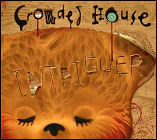 The announcement that Crowded House was getting back together was nothing short of a major surprise, and the first album following that announcement was a strange mix that started life as Neil Finn’s third solo album and really only included a handful of songs actually played by the reconstituted lineup of the band. Single selection was an even more awkward and political thing: strong songs were passed over in favor of those few that included the full lineup. The new album, Intriguer, has no such issues: the pre-publicity points out that the entire album emerged from band jams, and every track features the new lineup of Finn, Nick Seymour, Mark Hart and Matt Sherrod. Oddly enough, though, the result winds up sounding more like a Finn solo album than a Crowded House album, though at this point it’s probably a given that Finn solo is interchangeable with Crowded House at any given point, sort of like Jeff Lynne = ELO these days.
The announcement that Crowded House was getting back together was nothing short of a major surprise, and the first album following that announcement was a strange mix that started life as Neil Finn’s third solo album and really only included a handful of songs actually played by the reconstituted lineup of the band. Single selection was an even more awkward and political thing: strong songs were passed over in favor of those few that included the full lineup. The new album, Intriguer, has no such issues: the pre-publicity points out that the entire album emerged from band jams, and every track features the new lineup of Finn, Nick Seymour, Mark Hart and Matt Sherrod. Oddly enough, though, the result winds up sounding more like a Finn solo album than a Crowded House album, though at this point it’s probably a given that Finn solo is interchangeable with Crowded House at any given point, sort of like Jeff Lynne = ELO these days.
That’s not to say that it’s a bad album, not by a long stretch. And that’s also not to say that the Crowdies’ sound has ever been frozen in amber: the densely atmospheric Together Alone was a culture shock after the first three Mitchell Froom-produced albums. Intriguer is produced by Finn with Wilco producer Jim Scott, and the result winds up being neither as timeless as the Froom years, nor quite as adventurous as Together Alone. As with 2007’s Time On Earth and its lead single, this album is led by a rather unadventurous single, “Saturday Sun” – not a bad song, but not really attention-grabbing musically or stylistically.
Things get much more interesting with the third track, “Amsterdam”, which laments the city’s infamous reputation as a place where morality gets put on hold, in the form of a pleasant if downbeat ballad. The following track, “Either Side Of The World”, is very off-the-beaten-path for Crowded House, resembling – more than anything – “Paradise (Wherever You Are)” from the first Finn Brothers album. It’s got a jaunty tropical beat in which Sherrod really comes into his own at the drums – it’s a song that I can’t imagine Paul Hester playing, at least not this way. It’s odd that my favorite Crowded House songs these days sound nothing like what most people envision (i.e. Froom’s Hammond organ breaks) when they think of Crowded House. “Either Side” is an anthem to monogamy which goes more than skin-deep on the subject – not exactly a frequent topic of modern song lyrics.
“Isolation” seems to have been inspired by the pacing and arrangements of classic 1950s rock ballads, and is the second song to feature vocal contributions from Finn’s wife Sharon. Straight-ahead rocker “Twice If You’re Lucky” is probably the closest Intriguer comes to the early Crowded House sound, and it burrows its way into your subconscious quickly, along with the bittersweet “Even If”. But the experimentation is by no means a bad thing: the glue that holds every song together is Neil Finn’s rock-solid songwriting. (As legend would have it, when asked during an interview  what it’s like to be the greatest songwriter alive, Paul McCartney declined to answer on the grounds that Finn should hold that title. While I haven’t been able to source this oft-quoted interview, I’ll just settle for saying: ’nuff said.) No matter how “exotic” the style becomes, the songs at least have that going for them. “Even If” and “Elephants” deliver a double dose of wistful poignancy to slowly wind things to a close – which just means it’s time to start from the beginning again. Intriguer may take a little time to grow on you, but rest assured, it will.
what it’s like to be the greatest songwriter alive, Paul McCartney declined to answer on the grounds that Finn should hold that title. While I haven’t been able to source this oft-quoted interview, I’ll just settle for saying: ’nuff said.) No matter how “exotic” the style becomes, the songs at least have that going for them. “Even If” and “Elephants” deliver a double dose of wistful poignancy to slowly wind things to a close – which just means it’s time to start from the beginning again. Intriguer may take a little time to grow on you, but rest assured, it will.
- Saturday Sun (3:26)
- Archer’s Arrows (4:04)
- Amsterdam (3:34)
- Either Side Of The World (4:35)
- Falling Dove (4:35)
- Isolation (4:37)
- Twice If You’re Lucky (3:33)
- Inside Out (3:19)
- Even If (4:02)
- Elephants (4:30)
Released by: Fantasy
Release date: 2010
Total running time: 40:15
Devo – Something For Everybody
 Devo is back, sounding remarkably like they did back in the day (give or take a few advances in technology that showed up in recording studios in the intervening years), and this is one of the most welcome reunions I can think of in recent years. Because the secret to Devo wasn’t just their eccentric synth-heavy sound – it was that they applied that sound to some of the catchiest songs to come out of the ’70s and ’80s.
Devo is back, sounding remarkably like they did back in the day (give or take a few advances in technology that showed up in recording studios in the intervening years), and this is one of the most welcome reunions I can think of in recent years. Because the secret to Devo wasn’t just their eccentric synth-heavy sound – it was that they applied that sound to some of the catchiest songs to come out of the ’70s and ’80s.
Something For Everyone brings the original lineup back together, and most of the material here, while brand new, sits comfortably alongside their classic output. One song toward the end of the album, “No Place Like Home”, is about the only song that shows any signs that anyone had even the slightest inclination to modernize the signature Devo sound. Everything else is instant classic Devo.
Highlights include “Mind Games” (which explores another vintage ’80s sound with some quasi-chiptune elements), “Sumthing” (which tackles some clearly modern topics with its lyrics), and a new Devo anthem, “Later Is Now”. These songs – well, just about all of the songs on Something For Everyone – are as catchy as Devo’s ’80s favorites, without being slavish imitations of the material that the group has already done. It’s just about what they used to call “an album full of singles”. If there’s a low point, it’s the goofy spy spoof tune “Cameo”… and even then, it’s not that bad, just not up to the standard of the rest of the material.
If you’ve ever listened to a band get back together and then wondered “What happened to the sound I loved?”, Something For 
Everyone is proof that not every reunion is doomed to play out like that. Fortunately for Devo fans of old (or anyone who likes a catchy tune, for that matter), the New Traditionalists are back on the case. Given that it sometimes seems like the band’s old mantra of “devolution” seems to have come to pass in many parts of society, one wonders how we ever got by without them.
- Fresh (2:59)
- What We Do (3:17)
- Please Baby Please (2:41)
- Don’t Shoot (I’m A Man) (3:26)
- Mind Games (2:30)
- Human Rocket (3:22)
- Sumthin’ (2:46)
- Step Up (3:00)
- Cameo (2:49)
- Later Is Now (3:52)
- No Place Like Home (3:18)
- March On (3:50)
Released by: Warner Bros.
Release date: 2010
Total running time: 37:50
Alan Parsons – All Our Yesterdays
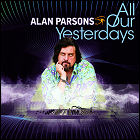 Six years after his last studio album (and mere months after his Eye 2 Eye live album), Alan Parsons is back with… a single? Essentially, that’s what this quietly-released digital duo is: an A-side and a B-side, sans album: a digital 45.
Six years after his last studio album (and mere months after his Eye 2 Eye live album), Alan Parsons is back with… a single? Essentially, that’s what this quietly-released digital duo is: an A-side and a B-side, sans album: a digital 45.
Parsons hasn’t been sitting idle, however; he’s spent the past few years shooting and editing an instructional DVD set, The Art & Science Of Sound Recording, covering the entire process of creating, recording and releasing music, and it’s from that other Alan Parsons project (sorry, couldn’t resist) that this single springs. The A-side, “All Our Yesterdays”, is followed throughout the DVDs as an example, from its inception through the final recording. The instrumental track “Alpha Centauri” is the theme music from the DVDs. In essence, these two songs make up the soundtrack of The Art & Science Of Sound Recording – and they’re a nice little spin-off on their own.
Anyone expecting more of the same from A Valid Path may think this is a step back, however. “All Our Yesterdays” isn’t quite low-tech, but it’s a more traditional rock number than A Valid Path‘s electronica-infused songs. (It fits nicely alongside material from Parsons’ On Air album in “feel”.) “Alpha Centauri” is an epic instrumental in classic Parsons style: hypnotically repeating echoplexed guitar riffs? Check. Orchestral backing that gradually builds in intensity? Check. Basically, “Alpha Centauri” follows in the mold of great Parsons instrumentals like “Mammagamma”.
 Parsons has said that he’s considering commencing work on a new studio album in 2010, but with a new tour (with a new touring band) announced for this summer as well, smart money is on a 2011 or later release. In the meantime, “All Our Yesterdays” and “Alpha Centauri” make for a nice bite-sized preview: hopefully Parsons isn’t done honing his own art (and/or science) of sound recording under his own name.
Parsons has said that he’s considering commencing work on a new studio album in 2010, but with a new tour (with a new touring band) announced for this summer as well, smart money is on a 2011 or later release. In the meantime, “All Our Yesterdays” and “Alpha Centauri” make for a nice bite-sized preview: hopefully Parsons isn’t done honing his own art (and/or science) of sound recording under his own name.
- All Our Yesterdays (4:31)
- Alpha Centauri (3:19)
Released by: Authentik
Release date: 2010
Total running time: 7:50
Star Trek III: The Search For Spock (Newly Expanded Edition) – music by James Horner
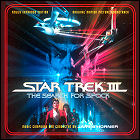 Fresh from the spectacular success – in archival soundtrack release terms – of last year’s complete score from Star Trek II: The Wrath Of Khan, Film Score Monthly (via its Retrograde Records imprint) did the “logical” thing and began work on a complete score release of the next movie in the classic Trek cycle, Star Trek III: The Search For Spock. Now, I’ve always been of the opinion that the Trek III score was less impressive than the music for Trek II by several orders of magnitude, but I began to wonder if perhaps that opinion was the product of poor choices made in the track selection and sequencing for the 45-or-so minute soundtrack release that’s been available all these years. Would the Trek III re-release, like that of its predecessor, reveal hidden depths that we’d been denied all these years?
Fresh from the spectacular success – in archival soundtrack release terms – of last year’s complete score from Star Trek II: The Wrath Of Khan, Film Score Monthly (via its Retrograde Records imprint) did the “logical” thing and began work on a complete score release of the next movie in the classic Trek cycle, Star Trek III: The Search For Spock. Now, I’ve always been of the opinion that the Trek III score was less impressive than the music for Trek II by several orders of magnitude, but I began to wonder if perhaps that opinion was the product of poor choices made in the track selection and sequencing for the 45-or-so minute soundtrack release that’s been available all these years. Would the Trek III re-release, like that of its predecessor, reveal hidden depths that we’d been denied all these years?
The answer is a roughly equal mix of yes and no. As with Trek II, the original release of Trek III‘s soundtrack bizarrely omitted some of the movie’s most iconic moments. The destruction of the Enterprise (“A Fighting Chance To Live”) is a rather major event in Trek history, but the music accompanying that scene didn’t rate inclusion on the old soundtrack release. It’s a beautiful piece, Horner at his best, and at nearly five minutes, it’s not a piece that’s so short that you could blink and miss it (a frequent excuse for not including a prominent cue on a soundtracka album). Another scene that always struck me musically – accompanied by the track “Sunset On Genesis” – is also a long-lost treasure. It’s nice to have the film version (rather than an “album edit”) of “Stealing The Enterprise”, though the difference isn’t enormous.
Unlike some critics, I’ve always thought Horner’s unique take on a musical signature for the Klingons was appropriate, fitting nicely alongside the “Klingon Battle” piece from The Motion Picture, but even wilder. (In any case, Goldsmith’s Klingon music from the first movie was almost more of a theme for V’Ger, and didn’t gain its signature bombast – a la Horner – until 1989’s Star Trek V: The Final Frontier.) It’s nice to hear Horner’s Klingon motif put through its paces (as in the track “Grissom Destroyed”).
Where things fall down is when the music slips into a single-high-note drone, mainly covering what could be called “Vulcan mysticism scenes”. They may have been appropriate for the film, but they’re extremely tedious as stand-alone listening. I would just skip these tracks and count off a few points, except that by the last third of the soundtrack, these tracks are so prevalent. Basically, after the Genesis planet is destroyed and Kirk & co. make off with their newly-acquired Klingon Bird of Pray, I tend to skip straight to the end. The first CD is rounded out by a selection of “source” music heard in the bar scenes as the Spock-possessed McCoy tries to wheel and deal for passage to the Genesis planet.
Due to contractual constraints involving the label that originally released the Trek III soundtrack LP, a second disc tags along with the first, replicating that LP in its entirety (although it’s been remastered, so it’s not a total loss). The second disc is essentially the same disc as what was released by GNP Crescendo in the early 1990s, and is the same as the original EMI LP released in 1984. The version of “Stealing The Enterprise” heard here differs slightly from the film version, but the real saving grace of the LP is the very dated, Meco-esque “Group 87” synth-disco cover of the theme music. Over-serious, dyed-in-the-wool soundtrack afficionados may hate it, but I’m glad to see it preserved here, even though it means a second CD that increased the price of the set.
 Overall, the new Trek III soundtrack is a worthy upgrade, but that worthiness is sometimes a little harder to find than it was with the much more listenable complete score from Trek II. There are persistent rumors – which, interestingly, haven’t been denied outright – that Film Score Monthly isn’t done mining Paramount’s music vaults for Star Trek material this year, so hopefully more musical delights await us from the final frontier.
Overall, the new Trek III soundtrack is a worthy upgrade, but that worthiness is sometimes a little harder to find than it was with the much more listenable complete score from Trek II. There are persistent rumors – which, interestingly, haven’t been denied outright – that Film Score Monthly isn’t done mining Paramount’s music vaults for Star Trek material this year, so hopefully more musical delights await us from the final frontier.
Disc One
- Prologue and Main Title (6:32)
- Klingons (5:59)
- Spock’s Cabin (1:41)
- The Klingon’s Plan (1:03)
- The Mind-Meld (2:32)
- Stealing The Enterprise (8:41)
- Grissom Destroyed (1:04)
- Sunset On Genesis (2:18)
- Spock Endures Pon Farr (3:04)
- Bird Of Prey Decloaks (3:48)
- A Fighting Chance To Live (3:54)
- Genesis Destroyed (2:43)
- Returning To Vulcan (4:58)
- The Katra Ritual (4:31)
- End Titles (6:19)
- That Old Black Magic / Tangerine / I Remember You (10:32)
Disc Two
- Prologue and Main Title (6:30)
- Klingons (5:58)
- Stealing The Enterprise (8:35)
The Mind-Meld (2:32)
- Bird Of Prey Decloaks (3:48)
- Returning To Vulcan (4:56)
- The Katra Ritual (4:31)
- End Titles (6:20)
- The Search For Spock performed by Group 87 (3:43)
Released by: Film Score Monthly / Retrograde Records
Release date: 2010
Disc one total running time: 79:39
Disc two total running time: 46:53
InnerSpace – music by Jerry Goldsmith
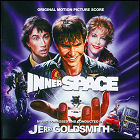 Not exactly a major box office hit, 1987’s Innerspace was an odd mix of science fiction action and romantic comedy whose two halves never quite made for one satisfying whole. The ingredients all seemed to be there, including Joe Dante behind the camera, impressive FX work, and an all-star 1980s cast including Dennis Quaid, Martin Short and Meg Ryan, but somehow Innerspace didn’t catch on. It also featured a score by the legendary Jerry Goldsmith, which may well be the one thing about the movie that does have staying power. La-La Land Records issued a nicely remastered edition on CD at the end of 2009, along with their usual generous helping of detailed liner notes that proclaim the musical score (but not the movie) of Innerspace to be a virtual sequel to Goldsmith’s music from Star Trek: The Motion Picture.
Not exactly a major box office hit, 1987’s Innerspace was an odd mix of science fiction action and romantic comedy whose two halves never quite made for one satisfying whole. The ingredients all seemed to be there, including Joe Dante behind the camera, impressive FX work, and an all-star 1980s cast including Dennis Quaid, Martin Short and Meg Ryan, but somehow Innerspace didn’t catch on. It also featured a score by the legendary Jerry Goldsmith, which may well be the one thing about the movie that does have staying power. La-La Land Records issued a nicely remastered edition on CD at the end of 2009, along with their usual generous helping of detailed liner notes that proclaim the musical score (but not the movie) of Innerspace to be a virtual sequel to Goldsmith’s music from Star Trek: The Motion Picture.
Is this true? Well, yes and no. Goldsmith does an admirable job of conjuring up that same sense of wonder that he employed in Trek, though of course the arrangement is different, and the one thing that would’ve made a strong connection between the two films’ music – the blaster beam instrument – is a no-show for Innerspace. But seeing that Goldsmith was writing and arranging music for Innerspace and not another Star Trek flick, that’s completely understandable: the literature trying to convince us that Trek fans will eat this up is, perhaps, overstating the case.
Taking up much more of the proceedings are a wistful Americana-flavored theme for Quaid’s washed-up (and washed-out) astronaut, and a comically threatening, twangy motif for the bizarre enemy agent played (complete with evil foreign accent) by Robert Picardo. Action cues begin commanding some of the action about 1/3 of the way though, and while they’re perfectly decent action music, they’re nothing groundbreaking by Goldsmith’s standards (but that still means it’s better than most movie action music).
 Innerspace is a more than competent movie score – Jerry Goldsmith never quite seemed to reach the stage where he was phoning it in, which is why fans go nuts when a score like Innerspace is released. If there’s a disservice here, it may well be the marketing hoopla comparing it to some of the composer’s even better works.
Innerspace is a more than competent movie score – Jerry Goldsmith never quite seemed to reach the stage where he was phoning it in, which is why fans go nuts when a score like Innerspace is released. If there’s a disservice here, it may well be the marketing hoopla comparing it to some of the composer’s even better works.
- Main Title (2:16)
- Take Him Home / Broken Toe (1:48)
- Tell Me About It (2:17)
- State of the Art / The Charge (6:55)
- Gas Attack (4:53)
- The Injection (2:12)
- The Hand / Fat Cells (1:01)
- Woman In Red (2:36)
- What Is It? (1:08)
- Optic Nerves (3:59)
- Take It Easy / It’s True (2:18)
- No Messenger (2:42)
- No Pain (1:57)
- User Friendly (1:39)
- A Close Look (1:34)
- The Cowboy (0:59)
- Hold It (3:41)
- For the Money / A New Man (3:40)
- How Do I Look? / Save It (1:45)
- Transformed (3:01)
- Retransformed (2:52)
- Where Am I? (2:12)
- The Womb (4:38)
- Fair Exchange (2:05)
- Stop The Car (5:59)
- Out Of The Pod (3:55)
- Disengage (3:00)
- No Red Lights (1:18)
Released by: La-La Land Records
Release date: 2009
Total running time: 78:20
Annie Haslam – Annie In Wonderland
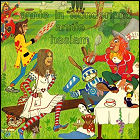 Taking a break from her “day job” as the lead female vocalist of ’70s prog rock outfit Renaissance, Annie Haslam set out to record a solo debut that was an outlet for her self-penned tunes that just didn’t fit the Renaissance house style – but that doesn’t mean it sounds like anything else released in 1977. Haslam recruited former Move, ELO and Wizzard frontman Roy Wood to produce the album, and Wood was already known for his own distinctive style. He also didn’t exactly have a long list of production credits for projects that weren’t The Move, ELO or Wizzard.
Taking a break from her “day job” as the lead female vocalist of ’70s prog rock outfit Renaissance, Annie Haslam set out to record a solo debut that was an outlet for her self-penned tunes that just didn’t fit the Renaissance house style – but that doesn’t mean it sounds like anything else released in 1977. Haslam recruited former Move, ELO and Wizzard frontman Roy Wood to produce the album, and Wood was already known for his own distinctive style. He also didn’t exactly have a long list of production credits for projects that weren’t The Move, ELO or Wizzard.
The result is a quirky and eminently listenable album that showcases Annie Haslam somewhere between her Carole King-esque singer/songwriter mode and something closer to Kate Bush territory, and also gives multi-instrumental whiz kid Wood full reign. A blast of brass opens the album with “If I Was Made Of Music”, but the production work never overshadows Haslam’s voice, which always has center stage. “I Never Believed In Love” is one of three songs actually written by Wood, and it bears the hallmarks of his vaguely-Beatlesque oddball Move-era songwriting.
It’s the next song, however, that can blow your hair back – Rodgers & Hammerstein’s “If I Loved You” (from the musical Carousel) gives Haslam’s considerably vocal range a real chance to shine, accompanied by an ocean of multi-tracked balalaikas. It’s not like any other rendition of this particular song or, indeed, like anything else you’ve heard before. (It’s not for nothing that, of all the songs on Annie In Wonderland, this song was chosen to be dissected and analyzed in detail on a BBC Radio special celebrating Roy Wood’s career.)
Almost as mind-blowing for its sheer display of Haslam’s near-operatic range is the soaring, wordless vocal of the otherwise-instrumental “Rockalise”. Drastic key/octave changes are also central to “Inside My Life”, which is as close as thiis album comes to typical ’70s singer/songwriter stylings – and in the capable hands of Haslam and Wood, it’s still not terribly close to typical.
What’s most surprising here is that this was the first and final collaboration between Annie Haslam and Roy Wood, but there’s another story there: they got engaged as Annie In Wonderland was being recorded, and never married over what’s said to have been a four-year relationship. Annie In Wonderland was a career-making album in the UK (and sadly overlooked elsewhere), and by all rights should have kick-started Wood’s career as well as Annie Haslam’s.  That it didn’t is truly sad; this album’s inventiveness and willingness to overstep the usual bounds of pop music are off-the-scale. Future collaborations could have been beneficial to all involved, but alas, it wasn’t to be, leaving Annie In Wonderland as a singular achievement that launched Haslam on a whole new career trajectory away from Renaissaince. Very highly recommended.
That it didn’t is truly sad; this album’s inventiveness and willingness to overstep the usual bounds of pop music are off-the-scale. Future collaborations could have been beneficial to all involved, but alas, it wasn’t to be, leaving Annie In Wonderland as a singular achievement that launched Haslam on a whole new career trajectory away from Renaissaince. Very highly recommended.
- Introlise / If I Were Made Of Music (4:46)
- I Never Believed In Love (3:40)
- If I Loved You (4:39)
- Hunioco (7:33)
- Rockalise (6:09)
- Nature Boy (4:56)
Inside My Life (4:51)
- Going Home (5:01)
Released by: Warner Bros.
Release date: 1977
Total running time: 41:35
Lenny Zakatek – Zakatek
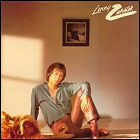 You may not know the name, but you do know the voice, at least if you’re of a certain age. Lenny Zakatek lent his distinctive, raw vocals to numerous Alan Parsons Project hits in the 1970s, including “I Wouldn’t Want To Be Like You” and “Games People Play”; for Zakatek’s debut solo album, Parsons was on hand to produce, to return the favor. The result is fairly typical late 1970s fare, showcasing a wider range of material than one might expect from Zakatek if one’s only prior exposure was his Project guest shots.
You may not know the name, but you do know the voice, at least if you’re of a certain age. Lenny Zakatek lent his distinctive, raw vocals to numerous Alan Parsons Project hits in the 1970s, including “I Wouldn’t Want To Be Like You” and “Games People Play”; for Zakatek’s debut solo album, Parsons was on hand to produce, to return the favor. The result is fairly typical late 1970s fare, showcasing a wider range of material than one might expect from Zakatek if one’s only prior exposure was his Project guest shots.
For one thing, Parsons and cohort Eric Woolfson would “cast” new material with certain vocalists in mind, and Zakatek used to wind up with bluesy, throat-thrasing numbers. For his own album, on which he’s singing everything for a change, Zakatek gets a chance to show off some more soulful chops – he’s not screaming every song at you.
With Parsons in the control booth, some of the songs get turned into epics, with female backup singers and orchestral backing aplenty. Only two songs are strong reminders of his roaring vocal work for Parsons’ group, “Doin’ It Right” and the extremely memorable “It’s A Dancer.”
Sadly, this album has faded into obscurity, without even a CD release, then or now. The influences and styles prevalent in 1979 keep it from being mistaken for anything you’d describe as “timeless”; more than a few of the songs are disco-lite. I’d be extremely surprised to see this  album show up on anything other than the original vinyl. A pity, since it’s an album that offers a glimpse into the other side of one of the more distinctive voices dominating the radio in the 1970s. Given how popular his songs for Parsons were, it’s honestly a bit of a surprise that Lenny Zakatek’s solo debut didn’t make a slightly bigger splash.
album show up on anything other than the original vinyl. A pity, since it’s an album that offers a glimpse into the other side of one of the more distinctive voices dominating the radio in the 1970s. Given how popular his songs for Parsons were, it’s honestly a bit of a surprise that Lenny Zakatek’s solo debut didn’t make a slightly bigger splash.
- Do It Right (3:55)
- One Is A Lonely Number (4:30)
- Was It Easy (3:20)
- Keep A Little Sunshine (3:54)
- Memories (3:45)
- Viens (4:30)
- We Will Never Find (5:10)
- It’s A Dancer (4:45)
Couldn’t We Try (4:30)
Released by: A&M
Release date: 1979
Total running time: 38:29
Little Boots – Hands
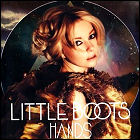 This might seem a bit “young” for my usual tastes, but Little Boots is an interesting act with a sound that makes it clear that someone – whether it’s the artist or her producer(s) – has a fixation on an ’80s-style sound that I used to know as “new wave.” (These days I think they call it electropop; I missed the memo when this change happened.) This sound has won Little Boots a consistent showing in the charts in the UK and Europe over the past several months, and it’s a sound that’s usually backed up by some pretty catchy songwriting.
This might seem a bit “young” for my usual tastes, but Little Boots is an interesting act with a sound that makes it clear that someone – whether it’s the artist or her producer(s) – has a fixation on an ’80s-style sound that I used to know as “new wave.” (These days I think they call it electropop; I missed the memo when this change happened.) This sound has won Little Boots a consistent showing in the charts in the UK and Europe over the past several months, and it’s a sound that’s usually backed up by some pretty catchy songwriting.
And how much credibility does Little Boots have with the (formerly) new wave crowd? Enough that her debut album features a duet with Human League frontman Philip Oakey – if that’s not an old-school new wave stamp of approval, then I’m not sure there is one. It’s also one of the highlights of the entire album, but not the only one by far. The dance-ready single “Remedy” is slightly more modern, but still puts wavering, wobbly ’80s analog-style synths front and center in the mix. “Stuck On Repeat” also smacks of a strong ’80s new wave influence, with a pulsating, repeating synth behind the entire song. It’s meant to be dance music, of course, but it stands up quite well musically.
 “Symmetry” and “Stuck On Repeat” are just two of the standouts; others include “Earthquake”, “Click” and “Hearts Collide”. The first single, “New In Town”, doesn’t strike me as having the staying power of some of the above, but it was popular enough in the UK. At any rate, enough of Hands is strong enough that Little Boots is an act that merits watching in the future.
“Symmetry” and “Stuck On Repeat” are just two of the standouts; others include “Earthquake”, “Click” and “Hearts Collide”. The first single, “New In Town”, doesn’t strike me as having the staying power of some of the above, but it was popular enough in the UK. At any rate, enough of Hands is strong enough that Little Boots is an act that merits watching in the future.
- New In Town (3:19)
- Earthquake (4:04)
- Stuck On Repeat (3:21)
- Click (3:16)
- Remedy (3:19)
- Meddle (3:16)
- Ghost (3:02)
- Mathematics (3:25)
- Symmetry (4:30)
Tune Into My Heart (3:41)
- Hearts Collide (3:45)
- No Brakes (4:01)
Released by: Atlantic
Release date: 2009
Total running time: 42:59
Dark Void – music by Bear McCreary
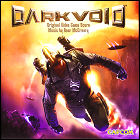 Best known for his densely percussive music for the revival of Battlestar Galactica, composer Bear McCreary makes no secret of his lifelong love of video games. If anything, that fixation is on display: a picture published on his blog several years ago reveals that the external hard drives containing the raw recording sound files of his sessions aren’t labeled with numbers or obvious names like “Galactica sessions”… instead, they’re named after characters from Capcom‘s Mega Man games, complete with colorful labels. So it’s fitting that Capcom should give McCreary his first shot at scoring a video game – but Dark Void definitely doesn’t sound like Mega Man.
Best known for his densely percussive music for the revival of Battlestar Galactica, composer Bear McCreary makes no secret of his lifelong love of video games. If anything, that fixation is on display: a picture published on his blog several years ago reveals that the external hard drives containing the raw recording sound files of his sessions aren’t labeled with numbers or obvious names like “Galactica sessions”… instead, they’re named after characters from Capcom‘s Mega Man games, complete with colorful labels. So it’s fitting that Capcom should give McCreary his first shot at scoring a video game – but Dark Void definitely doesn’t sound like Mega Man.
For one thing, McCreary refused to back down on his requirements for a real orchestra, real percussionists, and so on; Dark Void‘s music budget almost certainly took off like it had a jetpack of its own… but hey, it’s Bear McCreary. Sales of the soundtrack album almost certainly recouped what was an unusually large music budget for a video game – even in this day and age of games whose costs run into the millions of dollars and years of development.
And the music itself? Put simply, if you loved McCreary’s music for the Galactica finale, Daybreak (which is also out on CD), you’ll dig Dark Void. The music is fairly different – there aren’t any melodic similarities between Galactica’s heroic musical warfare and Dark Void‘s wistful main theme. But the execution is similar: the same blend of orchestra, a wall of exotic percussion and unusual instruments gives it the same feel as Galactica, without playing identical music.
And as for the 8-bit Mega Man tunes McCreary fell in love with before his mega-career in film music kicked off? He does chiptunes too (though we knew that from the Eureka soundtrack): the album closes out with an authentic, NES-style rendition of the Dark Void theme. McCreary did this track on his own time as an in-joke for the folks at Capcom, and they wound up inventing an entire extra game around it (the equally 8-bit-flavored DSware title Dark Void Zero,  which will have its own full soundtrack release as well). Talk about a composer influencing the project he’s working on!
which will have its own full soundtrack release as well). Talk about a composer influencing the project he’s working on!
Whether or not you’ve played the game, Dark Void is an outstanding treat for McCreary fans who may be mourning the end of “the Galactica sound.” The Dark Void score is like an unexpected encore at the end of a great concert.
- Theme From Dark Void (2:56)
- Prologue and Main Title (2:10)
- Village Attack (1:47)
- A Mysterious Jungle (4:20)
- Altar Sacrifice (1:09)
- Archon (3:19)
- Ava and the Rocket (2:01)
- Tesla’s Laboratory (1:21)
- The Prophesized One (2:58)
- Taking Flight (2:21)
- Crash Site (3:09)
- Void Requiem (7:49)
- Ava and Tesla Return (0:47)
- Above The Canopy (5:01)
- Hieroglyphs and Betrayal (3:03)
- Defending The Ark (5:45)
- The Collector (3:18)
- Survivor Camp Combat (6:17)
- The Watcher Airship (2:52)
- Watcher Prison (3:19)
- The Imperator (1:22)
- Will and Ava (1:52)
- The Dweller (3:46)
- Ava’s Sacrifice (3:17)
- Will At The River (0:38)
- Dark Void End Credits (2:02)
- Theme from Dark Void (Mega Version Bonus Track) (1:53)
Released by: Sumthing
Release date: 2010
Total running time: 79:33
Kelly Groucutt – Kelly
 Released on vinyl in 1982, and then reprinted on CD circa 2001 as a fan club exclusive and again as a general release in 2009, Kelly is the sole solo outing for the late Kelly Groucutt, whose musical claim to fame was as the bassist and soaring backup vocalist for ELO and, later, ELO Part II / The Orchestra. Groucutt had the help of most of his bandmates in recording his album, with the most conspicuous holdout being Jeff Lynne himself; perhaps not surprisingly, the entire album is very much in the style of ELO’s halcyon days (namely the mid/late 1970s). Groucutt was already an integral part of the ELO sound from that period, and Kelly can almost be seen – or heard – as an audition for the opportunity to take an even wider role creatively within the group.
Released on vinyl in 1982, and then reprinted on CD circa 2001 as a fan club exclusive and again as a general release in 2009, Kelly is the sole solo outing for the late Kelly Groucutt, whose musical claim to fame was as the bassist and soaring backup vocalist for ELO and, later, ELO Part II / The Orchestra. Groucutt had the help of most of his bandmates in recording his album, with the most conspicuous holdout being Jeff Lynne himself; perhaps not surprisingly, the entire album is very much in the style of ELO’s halcyon days (namely the mid/late 1970s). Groucutt was already an integral part of the ELO sound from that period, and Kelly can almost be seen – or heard – as an audition for the opportunity to take an even wider role creatively within the group.
As always, Groucutt’s vocal range is beyond merely impressive, and his singing voice doesn’t thin out when he edges toward baritone or falsetto. Having seen him play live with ELO Part II, I can vouch for the fact that the man could, quite simply, belt out a tune – and with his vocal abilities, he could belt out nearly any tune you can think of. But Kelly also shows off his songwriting abilities, and it’s quite evident that Groucutt was paying very very close attention to how songs were put together in ELO’s signature style; much of this album could fit in seamlessly on nearly any ELO album between Face The Music and Time (the ELO album whose release immediately preceded Kelly).
Songs like “Am I A Dreamer” (presented here in both demo and finished recordings) and “Sea Of Dreams” seem like they could’ve been strong candidates to become classic ELO songs. Groucutt also clearly shared Lynne’s love of classic ’50s rock – his background vocal arrangements are very reminiscent of Lynne’s work, but they also have just a hint of doo-wop to them. “Midnight Train” and “Black Hearted Woman” show ’70s roots, but the former especially highlights the unique rapport between Groucutt and ELO violinist Mik Kaminski, who provides hoedown-worthy fiddle work as well as coaxing “train whistle” effects out of his violin. The two would later form OrKestra, which would later be absorbed by ELO Part II.
There is, however, one huge problem with the re-release of Kelly that’s distressing: the sound quality. I’m assuming that the original vinyl release of Kelly didn’t sound like this does: the CD winds up sounding like it was mastered from a very well-worn cassette tape. Disappointingly, most of the songs sound tinny and hollow, with almost no bass frequencies… which is almost a slap in the face to the memory of someone who was, in fact, a bass player. Actually, I have a confession to make: back in the heady days of Napster, before this album was re-released, I downloaded several individual tracks from someone’s vinyl-to-CD-R copy of Kelly because I’d heard of the album but had never actually heard any of the songs… and to be brutally honest, the commercially-released CD sounds like it was mastered from those very badly-recorded, lo-fi MP3 tracks.
I give high marks for the music: Kelly Groucutt was willing, ready, and capable of taking a more direct creative role in the future of ELO, but – again, to be brutally honest – by this time Jeff Lynne had almost certainly realized that his future fortunes rested with holding the publishing rights to ELO’s output, and therefore wasn’t about to let go of the “central / sole songwriter” role. Which is unfortunate, because his sideman was clearly ready to help out. (I have to say that this also makes me reconsider Lynne’s more recent complaints, in some of the remastered ELO catalog’s liner notes, about bearing the heavy creative burden of the group alone; having heard Kelly, I call BS. More creative energy was there if he had only permitted it. I’m not going to say that a Lynne/Groucutt songwriting partnership would’ve  been another Lennon/McCartney, but it might have kept ELO on track or extended the group’s life span.)
been another Lennon/McCartney, but it might have kept ELO on track or extended the group’s life span.)
Now I’d just like to see someone honor Mr. Groucutt’s memory by carrying out a proper remastering of his one solo album. These are great songs – I’d just like to hear them in a sound quality that befits the quality of the songwriting and performance on display here. (Feel free to do the same with OrKestra’s unreleased-on-CD album too, while you’re at it.)
- Am I A Dreamer (3:45)
- Oh Little Darling (3:29)
- Dear Mama (4:33)
- You Don’t Need To Hold Me Tight (3:56)
- Black Hearted Woman (3:27)
- Midnight Train (3:52)
- Don’t Wanna Hear That Song Again (3:12)
- Anything Goes With Me (3:33)
- Can’t Stand The Morning (3:11)
- Old Rock & Roller (3:48)
- You’ve Been Telling Lies (3:10)
- Sea Of Dreams (4:47)
- I’ll Cry For You Tonight (4:06)
- Am I A Dreamer (3:42)
Released by: Renaissance
Release date: 1982 / reissued in 2009
Total running time: 52:31
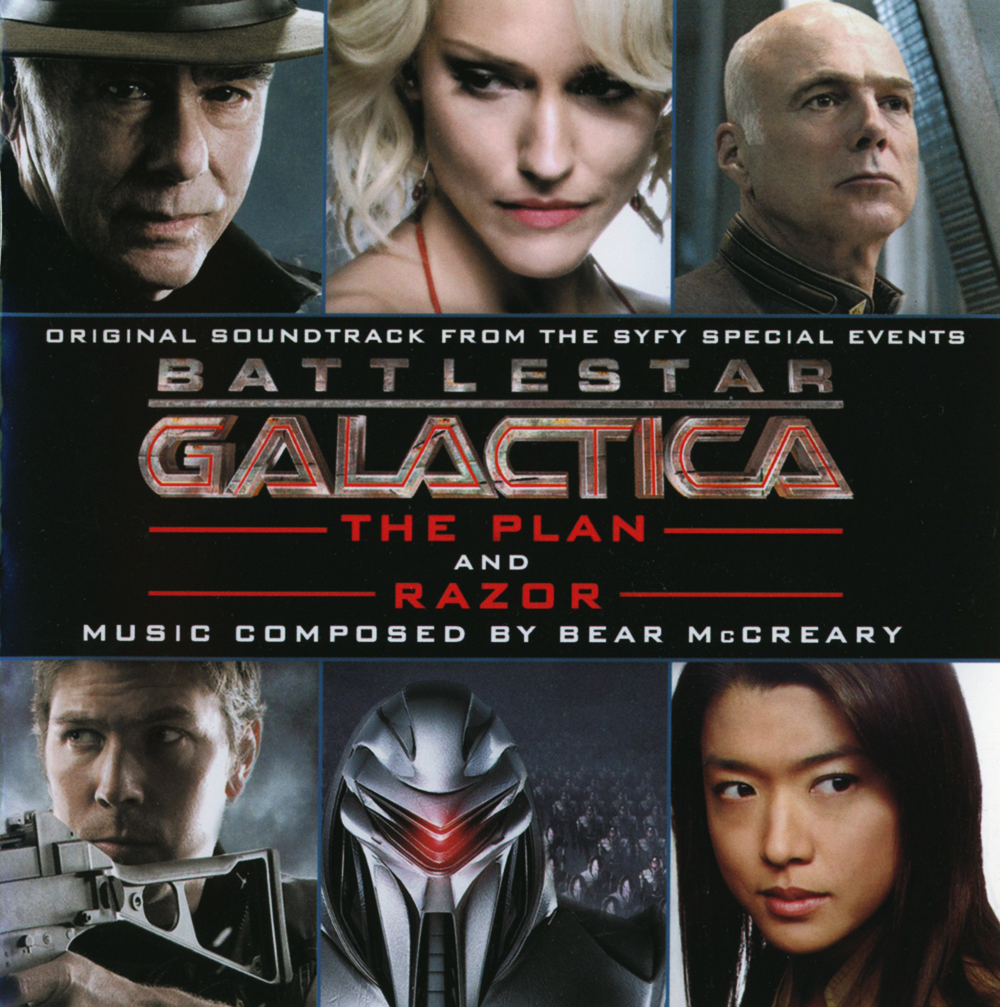
Battlestar Galactica: Razor / The Plan – music by Bear McCreary
 The new Battlestar Galactica gets one final hurrah in this soundtrack release covering the two made-for-DVD (and later broadcast on TV as a bit of an afterthought) movies, Razor and The Plan. Unlike earlier “season” soundtracks from the series, which followed a more or less chronological progression, this album becomes a bit more of a concept piece just by the novelty of its sequencing.
The new Battlestar Galactica gets one final hurrah in this soundtrack release covering the two made-for-DVD (and later broadcast on TV as a bit of an afterthought) movies, Razor and The Plan. Unlike earlier “season” soundtracks from the series, which followed a more or less chronological progression, this album becomes a bit more of a concept piece just by the novelty of its sequencing.
I hadn’t thought about it before seeing the CD’s track listing, but Razor and The Plan share a common story element: both show us the flip-side of past events that we’d either witnessed only from the perspective of Galactica’s crew, or heard about second-hand. Both movies’ flashbacks chronicle the Cylon destruction of the Twelve Colonies: The Plan shows it from the ground, Razor shows the destruction of the main Colonial shipyard (and the escape of one solitary battlestar). Composer Bear McCreary therefore took the unconventional approach of sequencing tracks in strict chronological order from inside the story: the tracks from both movies’ scenes of the Colonies’ destruction are grouped together, for example. With Razor and The Plan having been made and released a year apart, you might not expect much cohesion, but thanks to McCreary’s thoughtful approach to scoring the Galactica saga, everything fits together better than you might think.
The chief exception to this chronological ordering scheme is the first track, which is actually the end credit music from The Plan. Starting with a solo vocal version of the show’s main theme, “Apocalypse” quickly gets around to showing off its main feature, a crunchy heavy metal guitar riff by Anthrax axeman (and Galactica fan) Scott Ian. Much has been made of Ian’s contribution, and it’s a fairly unique sound for Galactica; the guitar work in the rest of the series has largely been done by Oingo Boingo’s Steve Bartek, and has been fairly intricate even when in screaming/searing mode. Ian’s guitar work is, by comparison, less ornamented – but with the unstoppable approach of the Cylons, maybe that’s the point: it’s the musical equivalent of the brutal bootsteps of an invading army. If you like the studio version of “Apocalypse” – which also appears in the extended, two-part version used within The Plan itself – there’s a great live version, performed by McCreary and the BSG Orchestra, that closes the album out.
But “Apocalypse” is an oddball here; much of the music from Razor and The Plan is what we’ve come to expect from McCreary’s nearly-unerring dramatic and musical sensibilities. Highlights include the attack on the Colonial shipyards (from which Pegasus narrowly escapes) in Razor, the whole “[insert planet name here] is burning!” sequence from The Plan, and the reappearance of Stu Phillips’ original Galactica theme in Razor‘s young-Adama-vs.-Cylon-parachutist flashback. Though it probably flies under most people’s radar here, I was also delighted to hear McCreary’s beautiful theme for Caprica from Daybreak resurface toward the end of The Plan‘s “Main Title” track.
For Galactica fans, this release neatly caps off the show’s musical canon; both movies sound like the series of which they are a part, and yet they also sound unique in their own right. But the inventive  sequencing which mixes-and-matches moments from both movies (though it never puts cues from both movies in the same track) reminds us that the similarities are greater than the differences – if there was a message to the whole show by the time The Plan‘s end credits rolled, I think that was it. As always, highly recommended.
sequencing which mixes-and-matches moments from both movies (though it never puts cues from both movies in the same track) reminds us that the similarities are greater than the differences – if there was a message to the whole show by the time The Plan‘s end credits rolled, I think that was it. As always, highly recommended.
By the way, if the live track at the end is a taster for a potential BSG Orchestra live album, I think that’d be a dandy thing to hear. Just sayin’.
- Apocalypse featuring Raya Yarbrough (4:07)
- Razor Main Title (2:13)
- Arriving At Pegasus (2:26)
- The Plan Main Title (4:34)
- Attack On The Scorpion Shipyards (3:37)
- Apocalypse, Part I (6:37)
- Apocalypse, Part II (2:36)
- Pegasus Aftermath (4:10)
- Kendra’s Memories (2:43)
- Mayhem On The Colonies (3:28)
- Civilian Standoff On The Scylla (2:57)
- Husker In Combat (1:54)
- Major Kendra Shaw (5:02)
- Cavil Kills and Cavil Spares featuring Raya Yarbrough (2:13)
- The Hybrid Awaits (2:43)
- Kendra And The Hybrid (6:06)
- Princes Of The Universe (3:57)
- Starbuck’s Destiny (0:41)
- Apocalypse (Live) (6:23)
Released by: La-La Land Records
Release date: 2010
Total running time: 68:27
Space 1999: Year Two – music by Derek Wadsworth
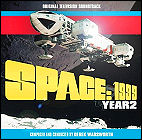 The often unfairly derided ’70s sci-fi melodrama Space: 1999 is a classic example of a TV show whose renewal came at the expense of a lot of creative interference. Wanting to ramp up the action and romance in an effort to boost ratings, please the advertisers and justify the expense of making the thing in the first place, ITV demanded a major overhaul of the show. Even the top-line actors weren’t immune: Barry Morse vanished without a trace or even so much as a later mention in dialogue. The carefully-designed, muted-color costumes were covered by new, more colorful jackets. And the show was now being run by none other than Fred Freiberger, a producer whom many credited with making the original Star Trek‘s third season its last.
The often unfairly derided ’70s sci-fi melodrama Space: 1999 is a classic example of a TV show whose renewal came at the expense of a lot of creative interference. Wanting to ramp up the action and romance in an effort to boost ratings, please the advertisers and justify the expense of making the thing in the first place, ITV demanded a major overhaul of the show. Even the top-line actors weren’t immune: Barry Morse vanished without a trace or even so much as a later mention in dialogue. The carefully-designed, muted-color costumes were covered by new, more colorful jackets. And the show was now being run by none other than Fred Freiberger, a producer whom many credited with making the original Star Trek‘s third season its last.
Oh, and the music changed a bit too. Space: 1999’s first season relied on a library of new compositions by longtime Gerry Anderson collaborator Barry Gray, as well as the music Gray had composed for other Anderson productions such as UFO, supplemented by occasional commercial music library tracks. Gray declined to take part in Space: 1999’s second season, leaving the composer job up in the air. While commercial library tracks would still be used, the new theme tune and all incidental music custom-made for the show was composed by Derek Wadsworth – and like the revised costumes, the new score was as colorful and shiny as the first season’s was dour.
Not that this will rate as an improvement for every listener. Fans of ’70s TV scoring – which often relied on the disco style prevalant on the radio at the same time – will find much to enjoy here, while those who preferred Barry Gray’s outstanding but bleak season one score may be left scratching their heads. Wadsworth’s music seems to be based largely on the arrangement and production style of Gamble & Huff’s “Philly soul” sound – it’s classic early disco, and in places it’s really good listening on its own, especially the track “Escape From Psychon”, from which excerpts were endlessly reused in moments of tension throughout the season. Whether or not modern sensibilities will decree this as suitable music for an ostensibly serious SF series is another matter, though it’s also worth noting that in its second year, Space: 1999 was seriously descending into the “camp” category – and then toward the end of that season, any hope of the show recovering its reputation was literally blown away by a little movie called Star Wars.
Culled from a limited-edition 2-CD set (now hopelessly rare and excruciatingly expensive) originally issued by the Gerry Anderson fan club Fanderson, this general release from Silva Screen concentrates entirely on Wadsworth’s work, which is good in that there’s a stylistic unity to the whole thing. Silva’s first season soundtrack included some library tracks, but that isn’t the case here. Again, I’m grateful to Silva for bringing this music to those of us who aren’t willing to skip a house payment to buy a soundtrack CD.
 Space: 1999 Year Two is good listening if you have a stomach for 1970s musical styles. Even if the arrangements were very 1970s, Wadsworth’s dramatic instincts were fairly sharp, and the lush arrangements for orchestra-with-some-rock/disco-elements indicated that the show’s producers were still spending money on the music. For those who can’t conceive of this being the sound of a TV science fiction series, Space: 1999 Year Two will either be an education or it’ll drive you crazy.
Space: 1999 Year Two is good listening if you have a stomach for 1970s musical styles. Even if the arrangements were very 1970s, Wadsworth’s dramatic instincts were fairly sharp, and the lush arrangements for orchestra-with-some-rock/disco-elements indicated that the show’s producers were still spending money on the music. For those who can’t conceive of this being the sound of a TV science fiction series, Space: 1999 Year Two will either be an education or it’ll drive you crazy.
- Space 1999 Year 2 Main Theme (0:49)
- Strange Light (3:00)
- Rendezvous In Space (5:53)
- Escape From Psychon (9:14)
- We’re All Aliens (1:57)
- A Swarm Of Space Bees (2:32)
- The First Capsule (3:06)
- The Exiles Emerge (4:40)
- Return To Golos (7:23)
- Make Me A Pretty Nose (1:10)
- Garden Of Vega (2:37)
- The Strongest Passion (2:35)
- Seduction (5:26)
- Alpha Ahoy (1:54)
- The Emporium (4:13)
- The Abduction Of Maya (4:02)
- Sore Loser (1:51)
- Light Years Away (5:28)
- Space Animal On The Loose (4:21)
- Showdown At Copernicus (7:06)
- Space 1999 Year 2 End Titles (0:32)
Released by: Silva Screen
Release date: 2009
Total running time: 79:49
Space Battleship Yamato: Rebirth Chapter
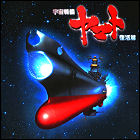 Sometimes I review soundtracks without having seen the movies first. Sometimes this happens because the soundtrack is part of a merchandising blitz ahead of the movie release (see: every Star Wars soundtrack over the past decade-and-then-some). Sometimes I just haven’t gotten around to seeing the movie yet, or the soundtrack’s been sent to me by the label ahead of the movie’s release. But this is a first: I haven’t seen the movie because it hasn’t been translated into my language yet. (For the record, I’ll take subs, dubs or both.) We’re talking about the first half of the surprising resuscitation of the Space Battleship Yamato franchise, better known in the English-speaking world as Star Blazers.
Sometimes I review soundtracks without having seen the movies first. Sometimes this happens because the soundtrack is part of a merchandising blitz ahead of the movie release (see: every Star Wars soundtrack over the past decade-and-then-some). Sometimes I just haven’t gotten around to seeing the movie yet, or the soundtrack’s been sent to me by the label ahead of the movie’s release. But this is a first: I haven’t seen the movie because it hasn’t been translated into my language yet. (For the record, I’ll take subs, dubs or both.) We’re talking about the first half of the surprising resuscitation of the Space Battleship Yamato franchise, better known in the English-speaking world as Star Blazers.
This revival is two-fold: the first-ever live-action film based on the classic anime series is expected at the end of this year. The first animated continuation of the original series in over a decade was released at the end of 2009. To say that both are eagerly awaited is an understatement along the lines of “Those Gamilon planet bombs sure are reducing property values around here.” This soundtrack, of course, is from the recently-released (but apparently not very financially successful) Space Battleship Yamato: Fukkatsu Hen (Space Battleship Yamato: Rebirth Chapter). Clocking in at over two hours, the movie may have gained bad word of mouth by ending on a cliffhanger promising resolution in further movies… which, naturally, could be endangered by this film’s cool reception at the box office.
So much time has passed since the last movie in the series (1983’s Final Yamato) that there were numerous impacts on the new film(s?), including the death of the original voice actor behind lead character Susumu Kodai and even the death of Hiroshi Miyagawa, the composer who created almost all of the original Yamato themes and scores. For Rebirth Chapter’s music, it was apparently decided to mix-and-match existing music from Miyagawa’s previous work (in the form of new arrangements with new bridging material by Naoto Otomo. If that’s not confusing enough, Final Yamato themes by the late Kentaro Henada are also referenced.
And then, if we aren’t already right on the edge of losing musical cohesion (though Otomo’s arrangements do wed the Yamato film and TV compositions quite nicely), roughly half of the soundtrack is taken up by selections from the classical canon. Perhaps the classical music is explained as a plot point of some kind in the movie, but simply as a listening experience, it’s disconcerting (ha!) to hear a thundering, hard-rock-with-orchestra remake of the original Yamato theme and then wind up with Beethoven and Grieg a few tracks later. As much as I love the new treatments of Miyagawa’s music, I really find myself wondering if a more cohesive end result couldn’t have been achieved by finding some new talent and allowing them the freedom to reference Miyagawa and Haneda – if they wanted to – among their own original work.
The highlights of the soundtrack are the first track – a gorgeous new recording of Miyagawa’s “The Universe Spreading To Infinity” theme (but not a significantly altered arrangement) – and especially track 6, “Yamato Hasshin”, which is the aforementioned rocked-out new version of the original Yamato theme, featuring J-pop band The Alfee. My favorite revived piece of Kentaro Haneda’s is “Fly-By Warp”.
 It’s hard to really judge fairly the odd balance of classical music and more-recent-but-still-recycled Yamato music without knowing what role the classical pieces may (or may not) play in the narrative. Someone’ll have to translate it for the western world so I can make that determination. But purely as a listening experience, Space Battleship Yamato: Rebirth Chapter’s soundtrack is pleasant enough, but never really establishes a feel that’s truly all its own.
It’s hard to really judge fairly the odd balance of classical music and more-recent-but-still-recycled Yamato music without knowing what role the classical pieces may (or may not) play in the narrative. Someone’ll have to translate it for the western world so I can make that determination. But purely as a listening experience, Space Battleship Yamato: Rebirth Chapter’s soundtrack is pleasant enough, but never really establishes a feel that’s truly all its own.
- Mugen Ni Hirogaru Uchuu (Miyagawa) (1:42)
- Cascade Black Hall (Mahler) (2:39)
- Kodai No Kikan (Miyagawa) (5:55)
- Wakamono Tachi (Miyagawa) (1:43)
- Hyoukai Ni Nemuru (Miyagawa) (3:13)
- Yamato Hasshin (Miyagawa / featuring The Alfee) (5:45)
- Senka No Uzu He (Kousuke Yamashita) (3:50)
- Fly-By Warp (Haneda) (2:47)
- Amar (Tchaikovsky) (5:35)
- Golui (Beethoven) (5:33)
- Joou Ilya (Chopin) (5:27)
- Mirai Heno Tatakai (Beethoven) (5:46)
- Sus Dai Yousai (Grieg) (5:46)
- “Fukkatsu Hen” No Tame No Symphony (Haneda) (4:17)
- Metzler (Kousuke Yamashita) (2:45)
- Kono Ai Wo Sasagete (featuring The Alfee) (6:00)
Released by: EMI Japan
Release date: 2009
Total running time: 65:32
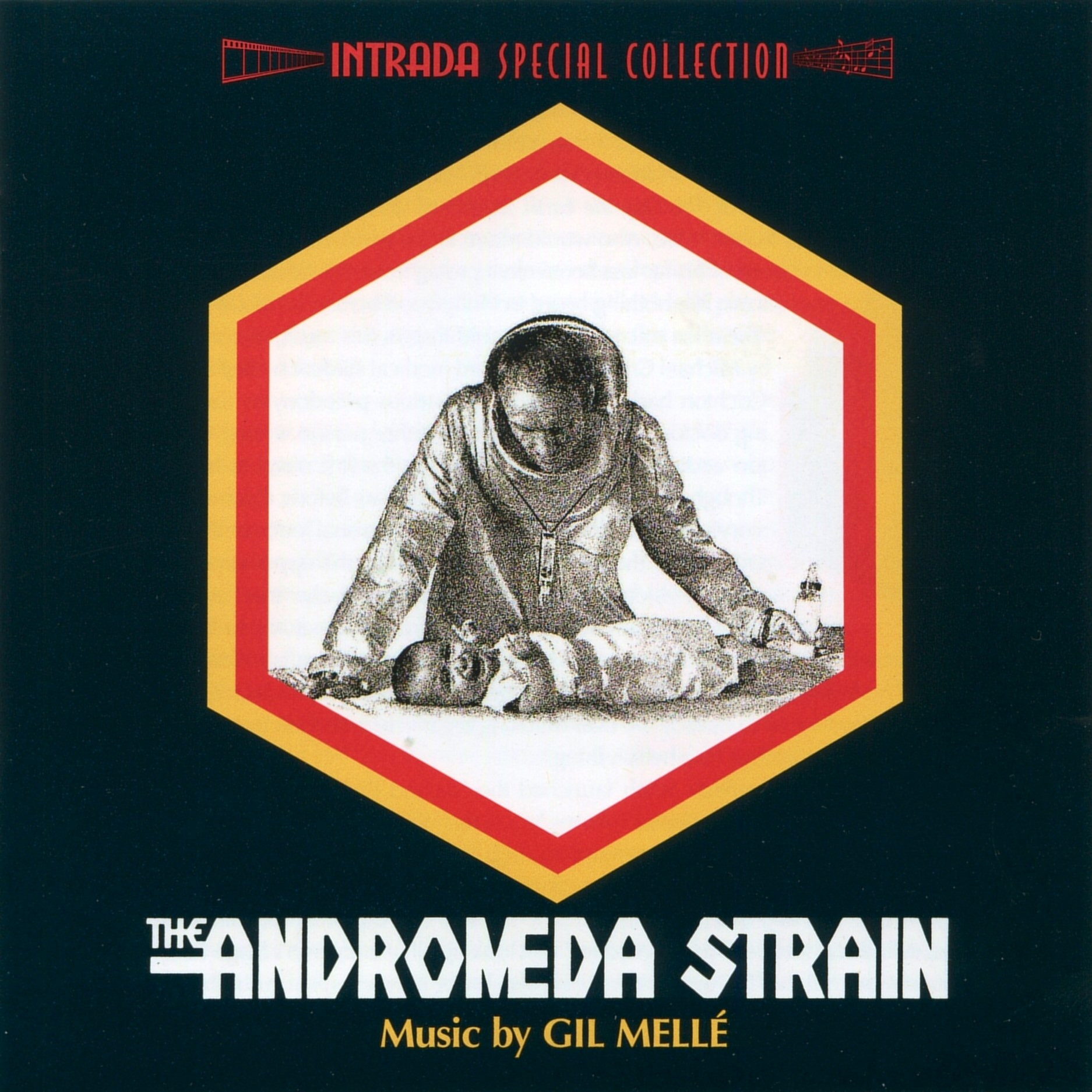
The Andromeda Strain – music by Gil Melle
In the early 1970s, while the British viewing public had been treated to electronic music in films and TV via the likes of Tristram Cary and the BBC Radiophonic Workshop, the film scoring scene in America had stayed rooted in orchestral scores and, increasingly, pop-music-compilations-as-soundtracks. The Andromeda Strain was a bit of an aural shock for moviegoers in the U.S., and its score, rooted in radiophonic methods and sounds, was extremely unusual – probably the strangest film score since Forbidden Planet.
Melle is associated with more traditional scoring, especially in the suspense/horror genre (Kolchak: The Night Stalker and Rod Serling’s Night Gallery being among his best-known work), but for this movie he used decidedly non-traditional means to create his music, with only a smattering of familiar instruments. The first three tracks really don’t make many concessions to an audience not already familiar with electronic music; “Desert Trip” is really the first truly tuneful track on the album. (“Desert Trip” also has a place in my own local history: one Fort Smith radio station which has held an annual Easter Egg hunt has used the middle portion of “Desert Trip” as the background music for on-air clues for as long as I can remember.)
“OP” and “Xenogensis” provide more material that borders on actually being melodic, but “Strobe Crystal Green” brings things full circle into the abstract. For those not accustomed to early electronic and radiophonic music, The Andromeda Strain soundtrack – away from the movie – can be a challenging listen at best, in the same vein as the music from the Doctor Who story The Sea Devils (broadcast the following year). Quite a bit of it isn’t just atonal, but eschews just about any notion of melody, harmony or rhythm, in either the western or eastern traditions. It’s not just noise, though: there is structure, just not in a traditional musical sense.
I frequently dock big points for a running time that clocks in well short of the capacity of a compact disc (especially at the premium price Intrada charges for its excellent limited-run soundtrack CDs), but there’s actually a historical reason for this one: when initially issued on  vinyl in 1971, The Andromeda Strain’s soundtrack was released as a hexagonal LP, and its running time was a byproduct of that unusual shape, since all of the tracks had to fit within a circular area within that hexagon. Intrada’s CD is round, but as it uses the LP master tapes as its source material, it has no more music than that hexagonal LP. Let the buyer beware of the running time vs. price ratio here.
vinyl in 1971, The Andromeda Strain’s soundtrack was released as a hexagonal LP, and its running time was a byproduct of that unusual shape, since all of the tracks had to fit within a circular area within that hexagon. Intrada’s CD is round, but as it uses the LP master tapes as its source material, it has no more music than that hexagonal LP. Let the buyer beware of the running time vs. price ratio here.
- Wildfire (2:46)
- Hex (4:00)
- Andromeda (2:24)
- Desert Trip (4:14)
- The Piedmont Elegy (2:23)
- OP (2:45)
- Xenogenesis (2:40)
- Strobe Crystal Green (4:55)
Released by: Intrada
Release date: 2010
Total running time: 26:07

White Noise – An Electric Storm
An Electric Storm is the adventurous debut album by a British outfit called White Noise. Even if the group is new to you, its members are familiar names: White Noise was a collaboration between electronic musician David Vorhaus and BBC Radiophonic Workshop members Brian Hodgson and Delia Derbyshire, doing a little bit of work on the side. Originally, White Noise set out to record a single only: two songs. Island Records insisted on an entire album of material… and unfortunately, that’s where it started to go downhill, rapidly.
An Electric Storm starts out promisingly enough, putting the two most interesting numbers up front. “Love Without Sound” and “My Game Of Loving” were the A and B sides of the originally planned single, showing off the concept behind White Noise very well: to apply the working methods of the Radiophonic Workshop to something that was intended, from the outset, to be a pop song or two. Even these two songs aren’t without issues, however. “Love Without Sound” has a fantastic, mysterious feel, with vocals that anticipate the singing style of the new wave and new romantic genres by a good ten years, and “My Game Of Loving” isn’t bad either, with almost Brian-Wilson-esque vocals.
But both songs become novelty tunes with the addition of intrusive laughter on the former and orgasmic moaning on the latter. The “instrumental” backgrounds – and I used that term loosely since, as with Derbyshire’s famous version of the Doctor Who theme, few traditional instruments were used – are intriguing. Any album with Derbyshire and Hodgson involved would have been spectacularly well-produced at the very least.
Though I’m not as fond of the music, this leaves the relatively uncluttered “Firebird” and “Your Hidden Dreams” as the gems of this album. “Here Come The Fleas” takes things firmly into novelty song territory.
The last two tracks on An Electric Storm are wanna-be epics that wind up weighing the whole endeavour down. “The Visitations” clocks in at over ten minutes, and few of those minutes stand out as interesting music, while “The Black Mass: An Electric Storm In Hell” is a noise montage with track after track of overdubbed screams, resulting in a piece that, quite frankly, I’d be happy never to hear again. Legend has it that the trio cranked out the two longest tracks in the shortest amount of studio time simply to fulfill Island’s demands for a full album. An Electric Storm in hell, indeed: it’s almost as if the group made a deal with the devil and was in a hurry to get out of it.
To be blunt, An Electric Storm is really the A and B sides of two decent, if trippy, singles, and a further collection of filler material that’s not worth the time (and keep in mind, very few times in theLogBook.com’s Music Reviews has it ever been said that anything’s not worth at least one listen for curiosity’s sake). There would’ve been no honor lost in just doing a four-song EP – and my opinion of this collection minus the three filler songs would’ve been  raised considerably. White Noise actually continues to this day, having released an album each decade since An Electric Storm, though most of the “group”‘s output since this album has been Vorhaus on his own; Derbyshire and Hodgson went their own way following this album. It’s a pioneering piece of electronic pop music, but the artistic achievement isn’t quite on par with the technical prowess on display.
raised considerably. White Noise actually continues to this day, having released an album each decade since An Electric Storm, though most of the “group”‘s output since this album has been Vorhaus on his own; Derbyshire and Hodgson went their own way following this album. It’s a pioneering piece of electronic pop music, but the artistic achievement isn’t quite on par with the technical prowess on display.
- Love Without Sound (3:07)
- My Game Of Loving (4:10)
- Here Come The Fleas (2:15)
- Firebird (3:05)
- Your Hidden Dreams (4:58)
- The Visitations (11:14)
- The Black Mass: An Electric Storm In Hell (7:22)
Released by: Island Records
Release date: 1969
Total running time: 36:11

